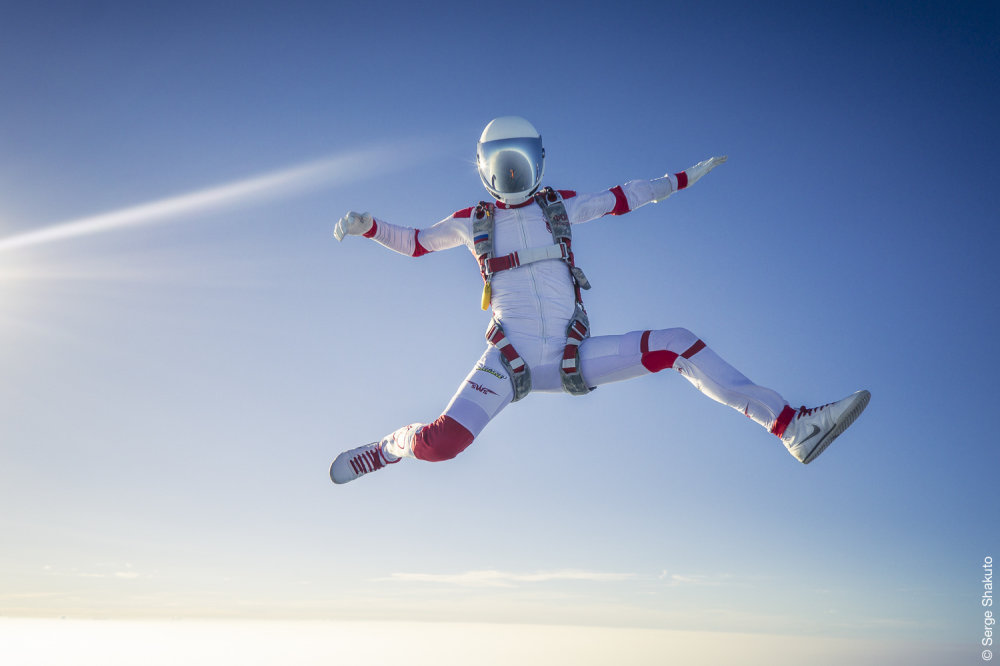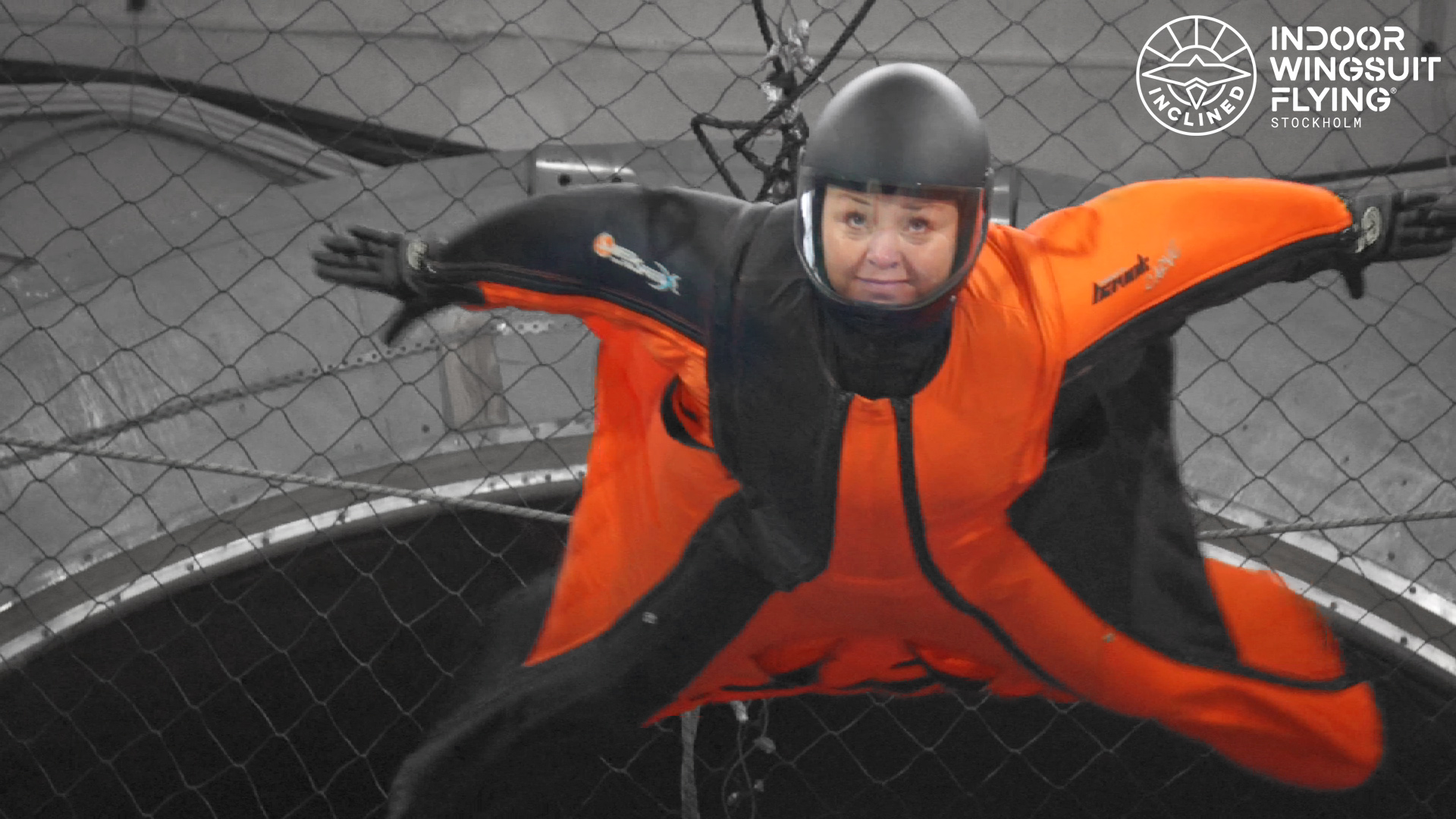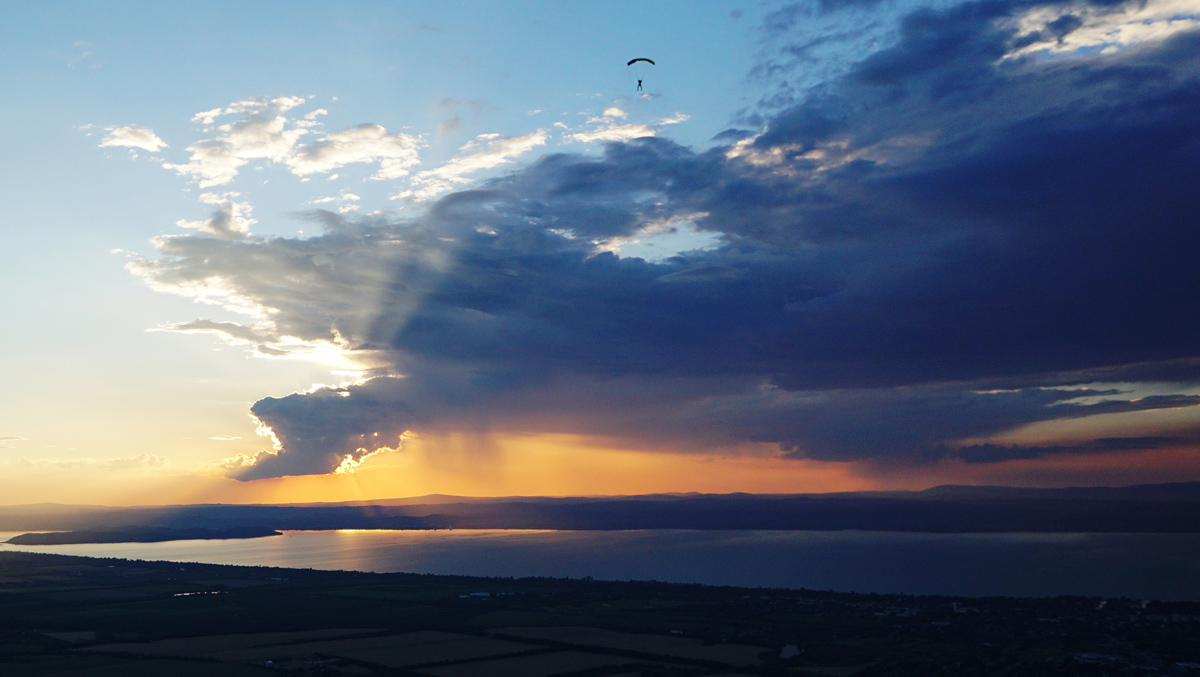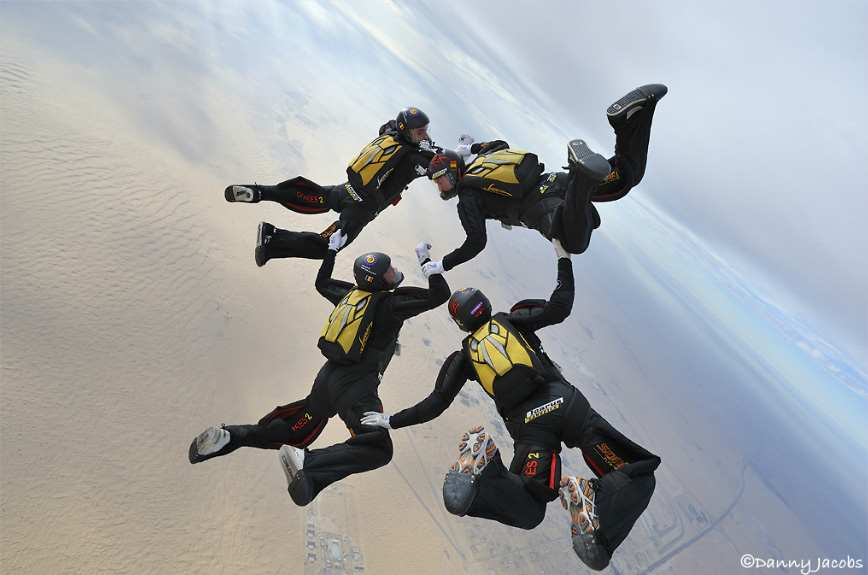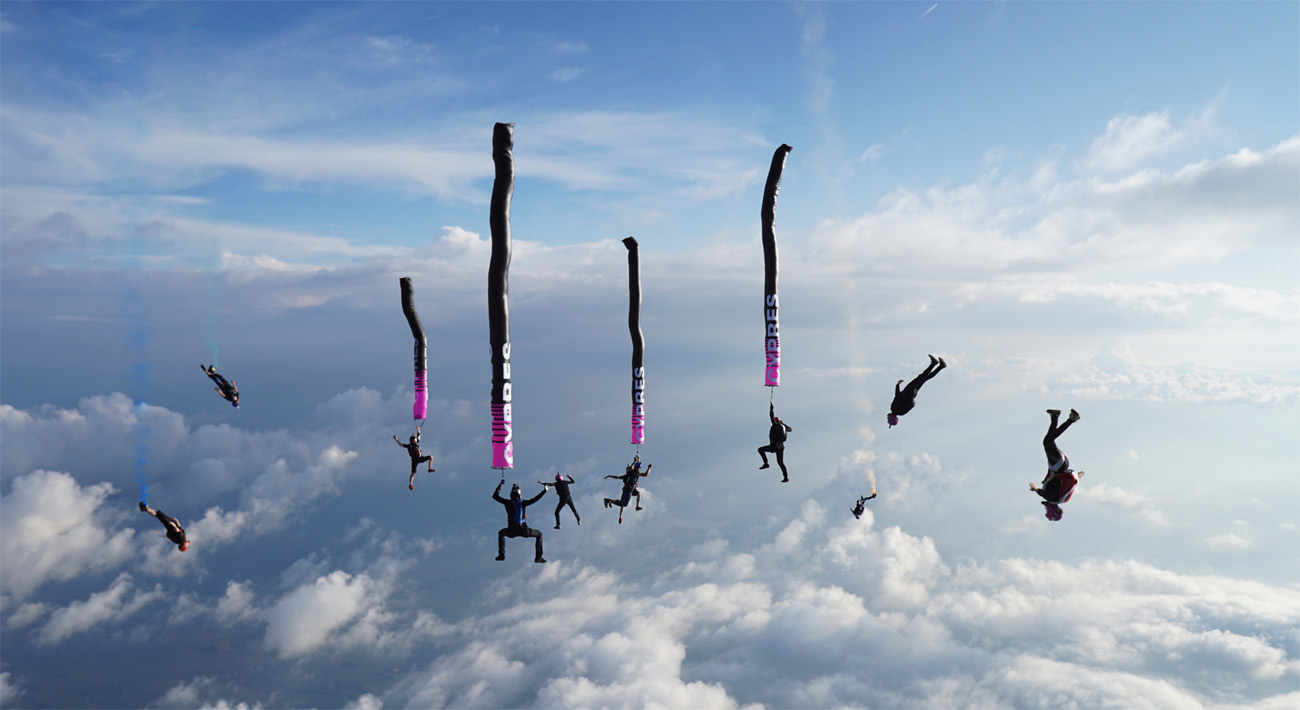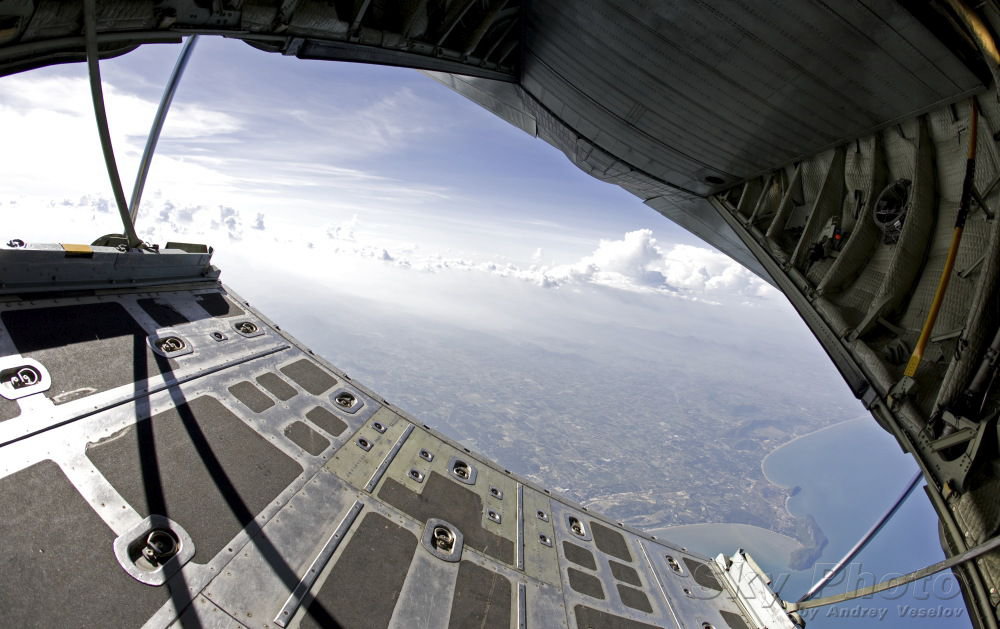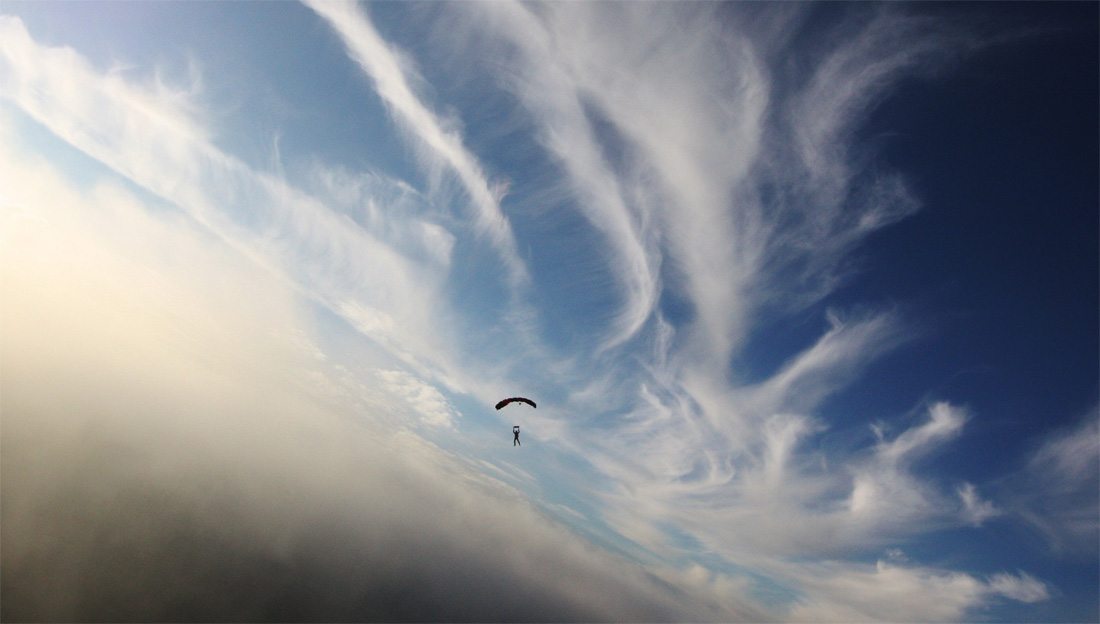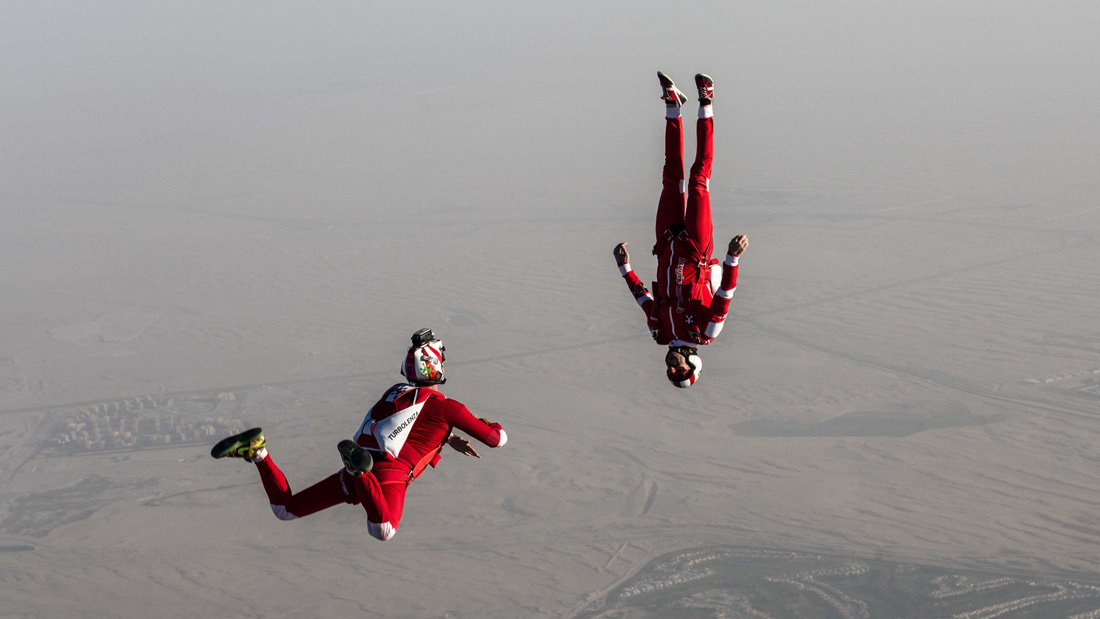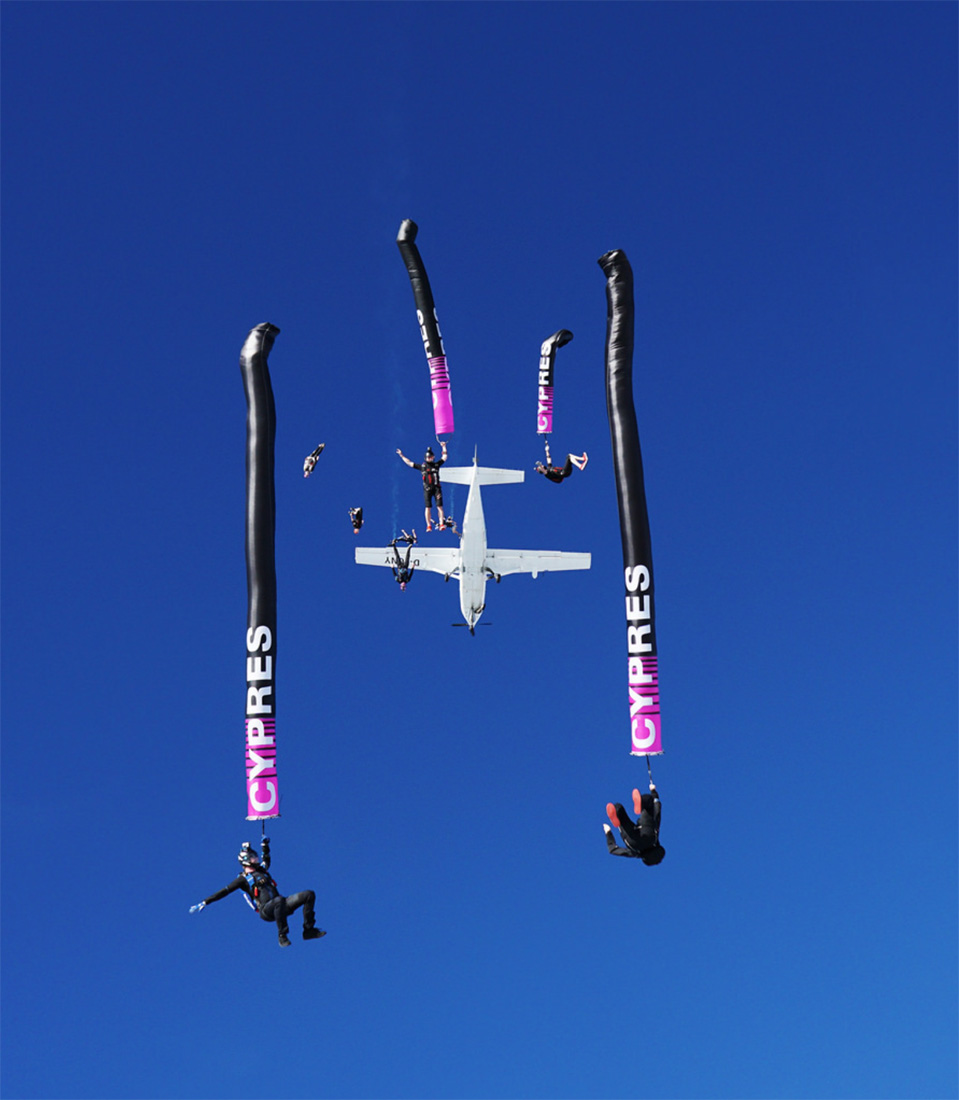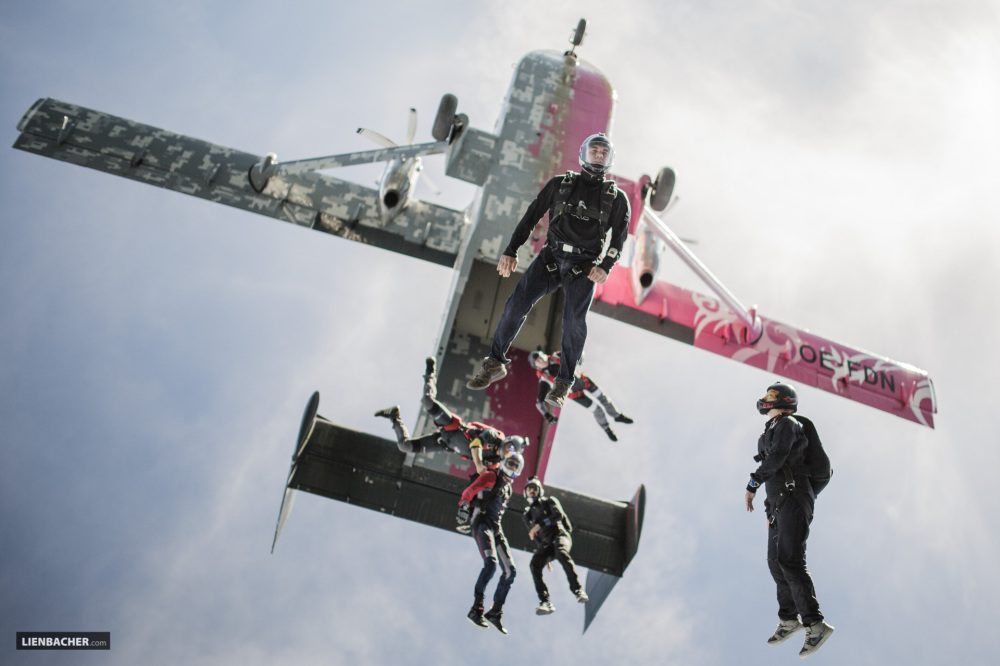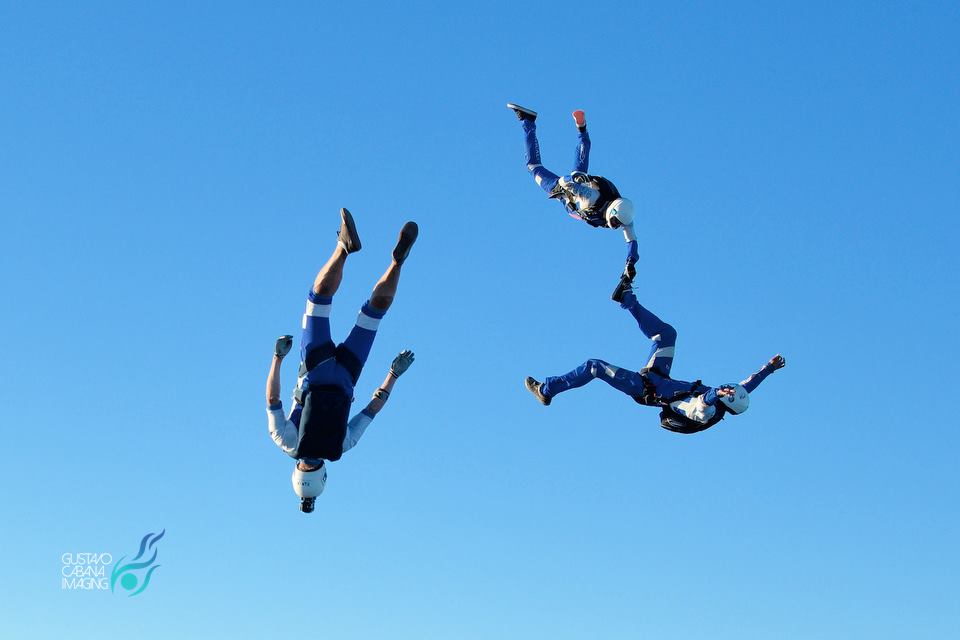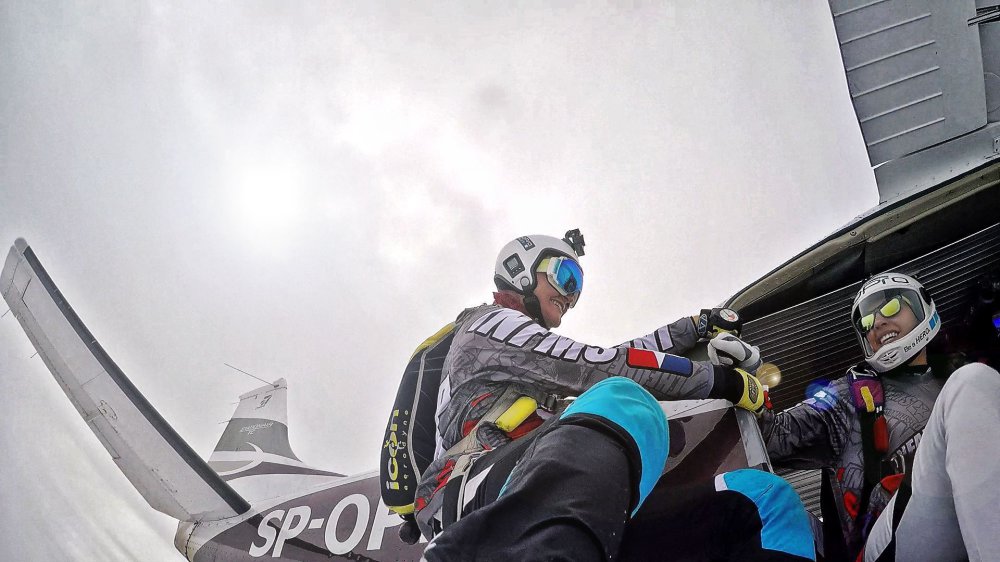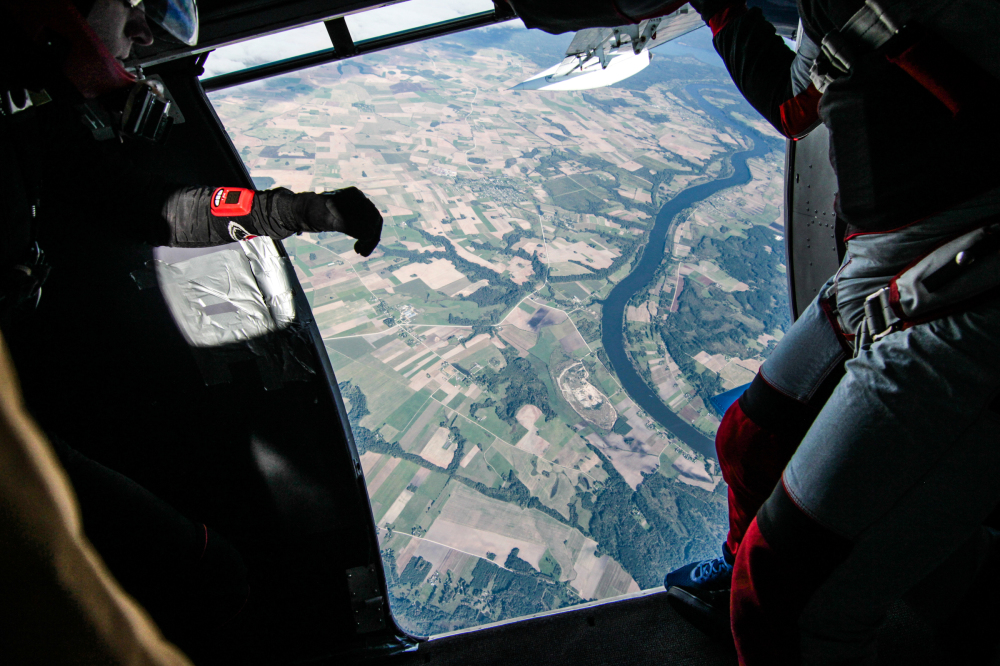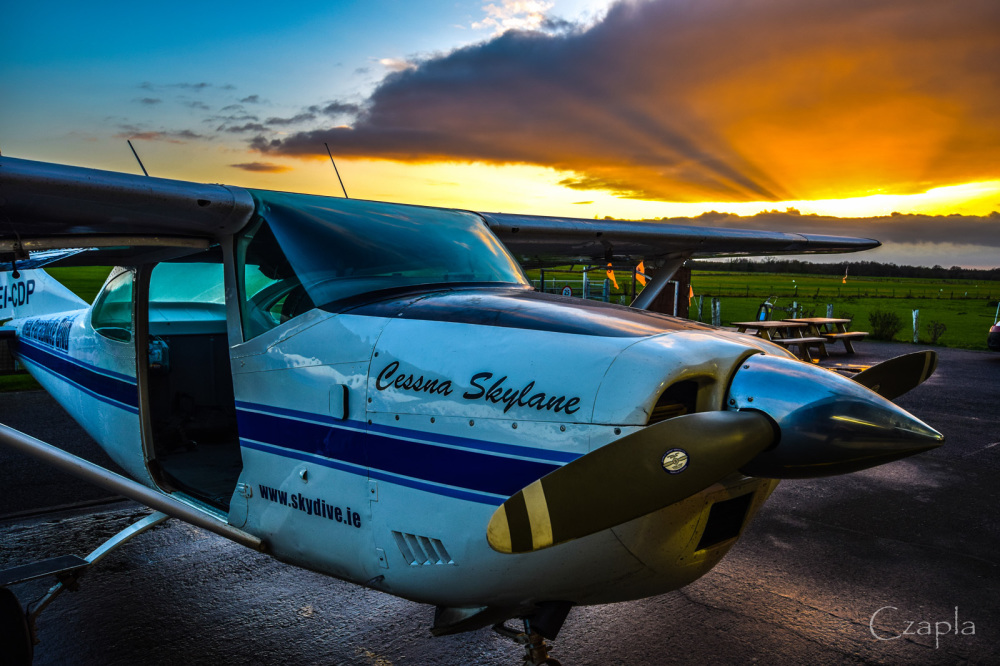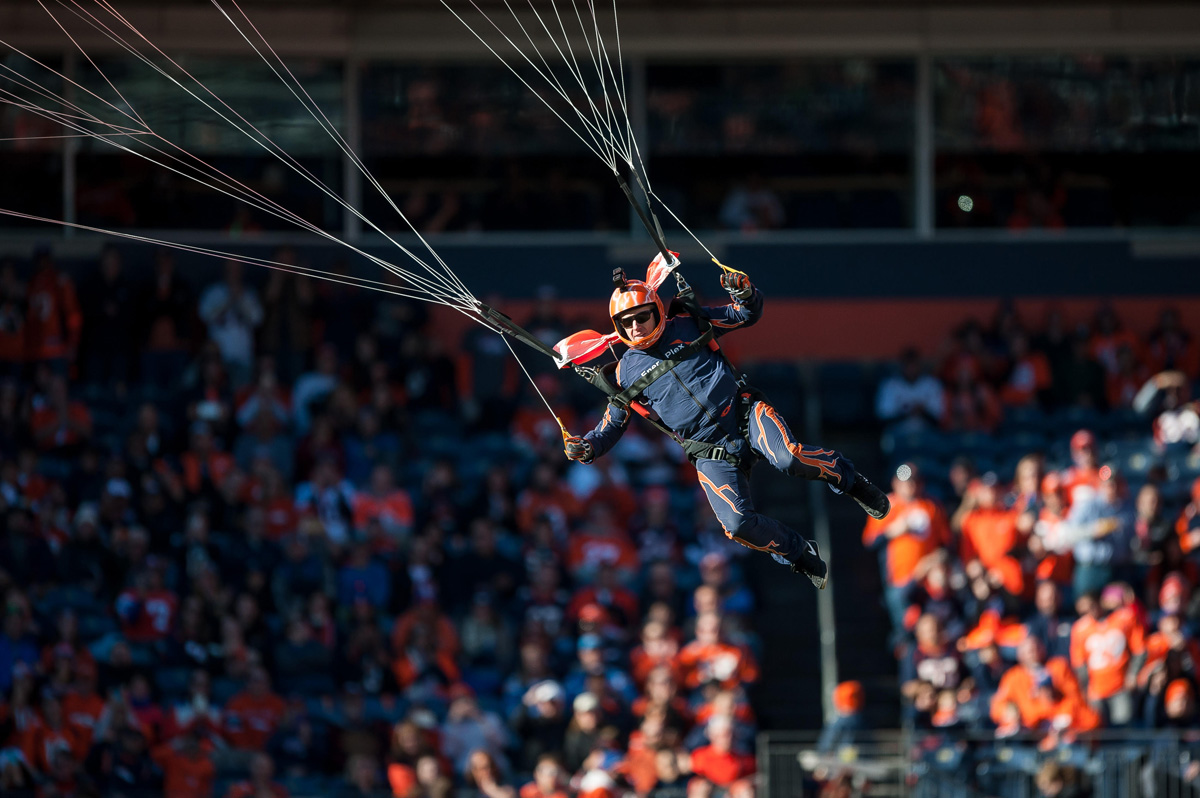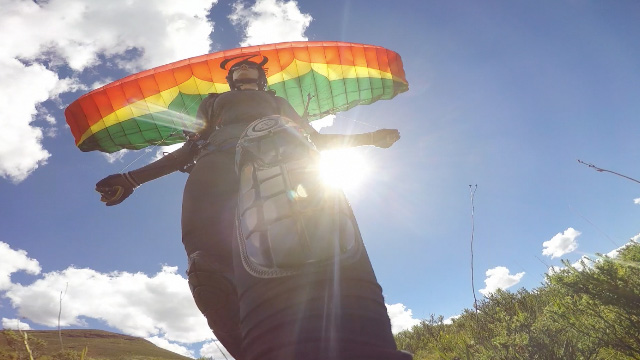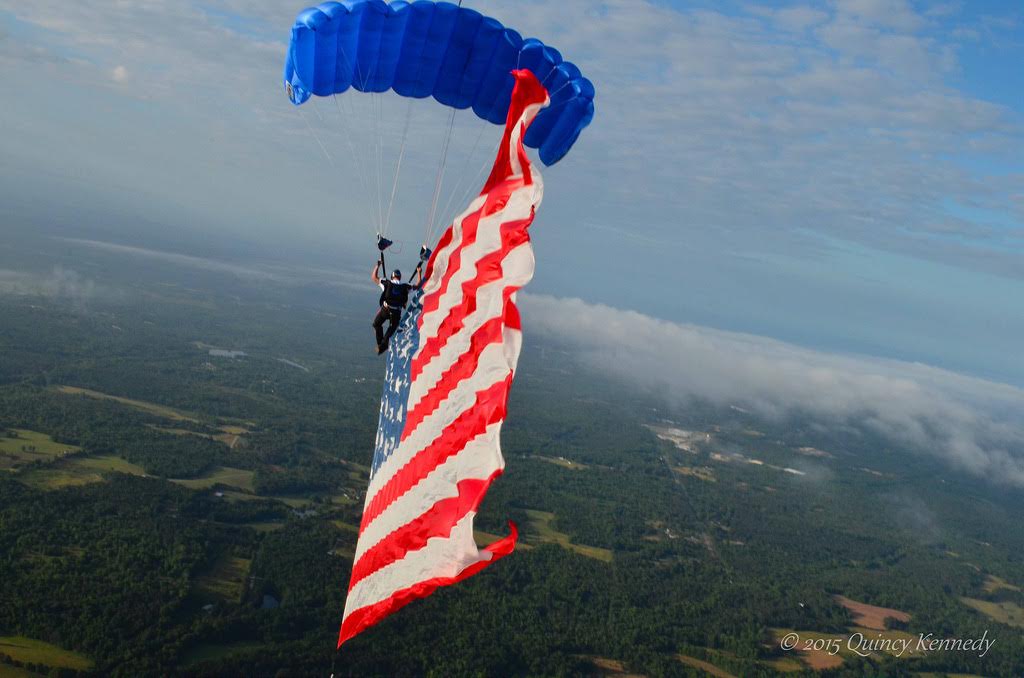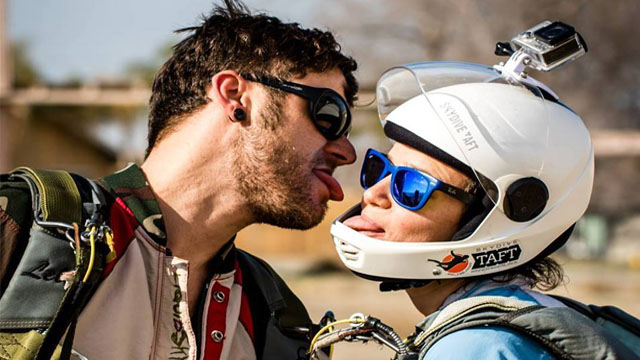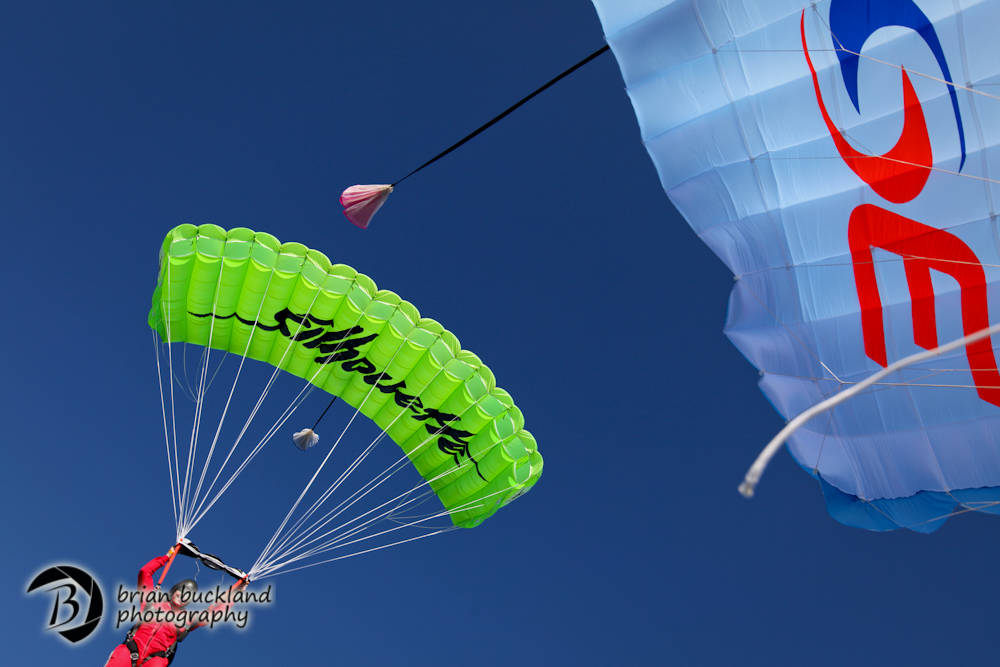Search the Community
Showing results for tags 'general'.
Found 265 results
-
Holistic Performance Specialist Lucie Charping Talks You In Image by Serge ShakutoLucie Charping grew up in the world of food and hospitality--but quite a bit more actively than you might imagine. She founded her first restaurant, in fact, at age 16. Lucie made the food-to-medicine connection early, too. Plagued by a variety of ailments throughout her childhood (as well as adrenal fatigue and a battle with anorexia, which almost killed her), Lucie healed herself through holistic nutrition. Eighteen years later, Lucie’s expertise centers on peak performance, sports injury management and plant-based nutrition--with a particular focus on lifestyle strategies for adventure sports practitioners, elite and Olympic athletes. I had the opportunity to pick Lucie’s brain about peak performance strategies for skydiving (and the shredding of tunnel gnar, to boot). Here’s what she had to say. ALO: So: tell us what you do! Lucie: I'm a peak-performance health coach. I’ve been a holistic nutrition coach for about 18 years. Originally, I worked exclusively within the Ayurvedic model--Indian medicine. These days, there is so much more western science and up-to-date nutritional information available, so I extended my practice to encompass it. The focus is two-pronged: first alignment, then optimization. Once you align your systems, the body can optimize. Most of my clients are adventure athletes of some kind who want to heal from their minor injuries faster; who want to be faster; who want to be clearer in their path towards performance in air sports and who want to have the mental energy that is takes to do these sports well. ALO: At what stage along this path do you usually meet a new client? Lucie: Usually, they come to me already having had an inkling of what needs to be adjusted. With a little bit of age and experience, top-level athletes--and people who want to become top-level athletes--discover for themselves the power of food-as-medicine to improve recovery rates, reduce inflammation, oxygenate more efficiently and focus better. Soon after that, if they’re paying attention--which they are, at that level--they realize that without using nutrition as a tool, they’re effectively shooting themselves in the foot. People come to me because they’re starting to realize how important it is and they want a customized, individualized plan of action--but you can do it for yourself, of course, if you’re willing to put in the research. You’d think that in top-level sports--airsports included--people would know what they need to know about nutrition. Unfortunately, they don’t. In order to be light and strong and focused, you need to eat and balance your body systems. ALO: Most folks that I know who do anything in the human-flight realm are under the impression that they’re doing pretty well, nutritionally. What’s the biggest problem you see with nutrition in airsports specifically? Lucie: In airsports, I come up again and again against the fact that people live predominantly on sugar. Soft drinks and lab-created bars are the major culprits behind the energy rollercoaster. Protein powders and bars replacing real food is a close second. There’s a perception that crap food is par for the course when you’re in the tunnel at 2 o'clock in the morning or out on a dropzone for the weekend--and then you don't know why you can't focus anymore, you don't know why you keep injuring yourself, why you're so frustrated all the time. It’s a matter of blood sugar and stress responses. Once you get your blood sugar and your stress responses under control, the training can rapidly come together. If you manage your body chemistry and your neurochemistry, you can absolutely catapult yourself. You can actually create an environment that sets you up for a state of peak performance--for a flow state. You can cultivate those states within your body, and how you do that is through your food choices and your relaxation practices. We all have these systems built into our bodies; we just need to learn to use them properly. There is a lot of science on this now--about how food choices and relaxation practices can optimize your learning rate; your motivation; your creativity; your focus. You can halve your learning time, for instance. The benefits are across-the-board. ALO: Let’s take a look at your typical skydiver. By that, I mean somebody in their late 20s to mid-30s who thinks that they eat pretty well, but definitely drinks socially--and probably has more quote-unquote “cheat days” than they would care to admit. This hypothetical jumper is starting to feel their age kicking in; starting to feel a little bit less, shall we say, unstoppable; starting to get the little nudges from their body that say something needs to be changed. What are the steps that you first recommend to that person? Lucie: The first thing I ask is simple: Are you eating enough food? Because in airsports--as in most sports--athletes don't eat regularly enough to balance blood sugar. Hangriness is hypoglycemia, which is crippling to an athlete. You can easily manage your blood sugar with plant protein and fiber (for example: hummus and carrots), even while you’re moving quickly at the dropzone. No matter how transient you are, you must think am I eating regularly enough and is my blood sugar stable. That’s step one. ALO: So you’re not telling people to drop everything and go raw vegan. Lucie: Absolutely not. I don't actually agree with that, anyway. I think that a whole-food, plant-based diet is the way forward for health and performance--but, as a coach, you have to meet a person exactly where they’re at. I can prescribe my perfect formula, but it will be a set-up for failure if the athlete can’t or won’t adhere. ----- Next week, Lucie talks about her favorite strategies to make that plan and stick to it.
-
With more than four thousand jumps over the last fourteen years, Jarno McCordia is one of the most experienced and highly respected wingsuit pilots in the world. Here he joins us to discuss a couple of upcoming projects from the pointy end of wingsuit flying. First up is a look at the soon-to-open indoor wingsuit facility in Stockholm. Towards the end of 2016 footage began to emerge of an angled tunnel facility in Sweden where some ambitious aeronautical engineers have been conspiring to do for wingsuit flying what vertical wind tunnels have done for our skydiving skills - change everything. Brought quietly onto the project in early 2016 by the founder of Phoenix Fly and wingsuit development grand wizard Robert Pecnik, Jarno immediately saw the potential: “The whole thing was already underway a fair bit when I got involved in an active way. Secretly Robert had already been working for almost a year with the team behind the technology to realise the project. The first test flights had already been done when I was invited to come take a look at the flying and help assess things - mostly from an instructional point of view but also to see how far we could push the flying. Normally a lot of the development and testing we do together is open and shared process - so to have Robert tell me he had some news but couldn't show me anything until we met in person made me suspect it was something big.” “The flying I saw at that point was just steady cruising, but it immediately made me realise what I was seeing and the potential of how it could change the sport in a similar way that indoor skydiving transformed Freefly and FS in terms of skills and training.” Many disciplines within skydiving are evolving quickly and wingsuit flying is no exception. Suit designs are continually updated as our methods are refined and our abilities better understood. Steep and fast is the way to maximise the potential of a wingsuit - but getting it right takes time. How does the tunnel work and what have you learned about the instruction process so far? “The whole tunnel chamber is a moving structure of which the angle can be altered from pretty much flat to almost vertical. This ability to do this gives us a glide ratio varying from 1:1 all the way up to 3.65:1 (comfortably more than the sustained full glide on high range wingsuits) and the controllable speed of the tunnel is from 0 to almost 300km/h. Balancing these two factors means the tunnel is able to match the glide angle and for the suit one is flying and be appropriate for the skill level of the pilot. We have looked a lot at the teaching technique for beginners as we see that as being a significant percentage of customers. Experienced wingsuit pilots will also need to learn the basics first so that was an important area to focus on.” The indoor skydiving industry has a complex system of managing students abilities while they are training developed over many years . With good quality instruction accidents are few and far between but there is still some inherent risk. What have you learned so far about keeping people safe? “In terms of spotting and safety, procedures will vary a lot from what people are used to. I cannot go into to much detail yet due to a pending patent, but there is an assisted flight system that holds the student in a central position in the tunnel. There is free range of movement in all directions but only up a certain degree. In a similar way to how a seatbelt works, any rapid movement towards the ground or the walls is halted in a gentle way. Once pilots reach the stage where they can fly around free without any assistance it will be possible to get into close contact with the floor and walls, though experience has shown that the lower windspeed and design of the tunnel make those situations a lot less severe than one would expect. I’ve been practicing some quite aggressive acrobatics and of course it does not always go down without a hitch, though due to the padding and angle of the chamber you never really hit hard and you get gently rolled down to the floor - feet first.” “Initially there is something very intimidating about flying in a confined space but it pushes the accuracy and precision of your flying to a new level. It has definitely helped me realise how much further we can develop the precision of our flying. Even in the smaller test setup we have been flying 2-way and performing advanced acrobatics. Once the full-scale tunnel opens in September the possibilities are limitless - we are already going to host the first indoor acrobatics competition in December. LT1 is currently scheduled to open in September 2017. You can read more about the project and the history of the facility here: https://flywingsuit.se/
-
It is easy to think of the weather as just being big. All too often as skydivers we assess things in very general terms without really worrying too much about the details - yet the most direct impact weather conditions can have on your skydiving can happen on an entirely personal level, affecting you and you alone while trying to successfully land a parachute. I make no claim to being a canopy piloting coach and should you wish to further your skills in that area I recommend seeking out humans that offer professional structured courses in these matters. What follows is simple advice designed to encourage further learning by pointing out some of the more common weather phenomena that you will encounter above and around the dropzone. Turbulence:When wind hits something it bounces off in different directions which can cause difficulties for flying one’s parachute through if you are not prepared for it. Dropzones are hugely diverse in terms of layout and construction - from the humble Cessna using a strip of grass in the middle of nowhere to powerhouse operations that utilise a fleet of aircraft and resemble a municipal airport, however wherever you jump the same general rules about what to look for apply. Below I have included some examples and a few shit-but-accurate pictures to demonstrate how wind behaves over and around common obstacles. By referring to these you can get some idea about how to be aware of potential hazards and avoid them when necessary. Wind over building Wind over hill Wind over ridge Wind over trees Unstable Air - When the wind hits something big and flat like a hangar it spills out in lots of different directions at the same time. Depending on exactly where you are this could cause lift, sink, sideways motion or all of these in quick succession. Things can get really rough next to structures when it is windy - so use your brain, apply your training and be somewhere else. Wind Shadow - A large enough object might create an area behind it which is clear of the turbulence and has no wind. Where you were previously crabbing like mad or going nowhere fast - if you enter a wind shadow you might suddenly find you have a surge in ground speed and have to adjust where you though you were going to land. Be very ready for more turbulence. Bottleneck - This is when wind speeds up rapidly to squeeze a large volume of air in a small gap between two objects. This can also be compounded by the other problems created by wind trying to get around things such as an increase in instability. Thermal Activity:Thermal activity is generated by the sun heating the air - warm air expands pushing outwards and cold air contracts drawing inwards, causing wind. The most common experience most of us initially have with this effect is via some toothy weather person gesticulating at region-wide areas of a greenscreen map on the telly and describing which way the wind will most likely be pointing. However - thermals gather and release on a much, much smaller scale than this and can be localised enough to effect your flight while navigating a canopy. Things to look for are items and areas that are good at causing lift by either reflecting heat such as tarmac (runway/carpark/roads) and metal (hangars), or storing heat such as bodies of water. A small amount of thermal activity is not going to cause serious issues with your flight pattern or your canopy’s performance but some sudden lift or sink when you are not expecting it can mean the difference between landing in your intended spot and somewhere else. In some places thermals can be surprisingly violent and threaten your safety - ask anyone who has tussled with an Arizona dust devil that sprang as if from nowhere on an otherwise perfect skydiving day. Behaviour:So what do you do when things get more challenging? Dropzones operate under official limits for jumping and will often have their own rules in place for particular conditions. For example you might be required to land in a different area if the wind is coming from a certain direction or you might have to stop jumping sooner than you were planning due to a particular quirk in the local terrain. Learn these special circumstances and understand why they exist - you never know when such knowledge will help you make a good decision somewhere unfamiliar when the pressure is on. Despite established parameters the person responsible for your safety is you. If you decide keep jumping as conditions get ‘interesting’ it is only sensible to modify your behaviour for increased safety: If it is getting super windy then use any available space and land clear of hazards and other canopies. Walking a long way back to the hangar is better than crawling even the shortest distance if you have to do it into the back of an ambulance. Landing crosswind or downwind into clear space and sliding across the grass like a goose landing on a frozen pond is better than turning low into the wind and flying face-first into the ground. If the wind is actively changing direction as you look at the indicators then follow the rules and land the way the arrow is pointing. Again - it is safer to all land in the same direction regardless of which way the wind is going than all try to face into it as it moves around and risk a collision. Watch other people land. If the wind is getting up then maybe have a break and watch a load or two. Assess everyone from Captain swoopypants all the way through to the tandems and those with lower experience. Try to develop a habitual curiosity about what is going on at the particular spot you like to skydive. Many noteworthy incidents in our sport can be traced back to awareness of small things that could easily be avoided with a little learning.
-
Learning About Weather: Part 3 - Upgrade Your Grey Matter
joelstrickland posted an article in General
There are lots of things you can learn about on the Dropzone that will aid you understanding of how all the elements involved in a skydiving operation fit together to make things work. Even just focusing on the assessment of the jumping conditions demonstrates several moving parts that all need to operate effectively to function as a whole. Remember, there are things that you must know, but also things that you can know that will make you better and safer. A helpful way to evolve your knowledge is try to see things from the perspective of others. What Other People Know:Chief Instructor: Whoever is employed to be in charge of the daily dropzone proceedings will not only be generally very well experienced but likely also highly practised under the conditions of that particular location. You can learn much from this person. When things are busy they will likely juggling many things in their head to keep everything running smoothly, but when quietness descends seek them out and pick their brains as they probably have many, many excellent stories to share - each with an important lesson behind it. The Pilot: To become a pilot you have to read books and do tests and stuff. A lot of this is about the weather. While you are trying to gauge the strength of the wind outside by listening intently from under a duvet - a good pilot will be up checking many sources of information to be able to perform their job properly. The information analysed by pilots is a very good place to head if you are keen to take your knowledge about flying conditions to the next level. The Jump Master: The person who is in charge of the load needs to be very aware of what is going on both on the ground and in the air. Being tasked as jump master is a serious job that happens relatively early in your skydiving career and while easy to perform with the correct level of awareness carries serious responsibility when there is some kind of incident. Are you confident enough in your decision to take the plane around or bring it back down after spotting a big mess at altitude and have the courage of your convictions when faced with an angry dropzone owner? Being all over the details will make you look like a goddam pro when anyone starts quizzing you. What were the winds doing at the bottom and the top? Which way was it going? What kind of clouds were they and at what altitude? The Other Skydivers: Does everyone on the plane know what they need to know? Are the people you are jumping with or those in the group next to you clueless idiots? Should you worry about them? Who is going to tell them the correct information? You do it - for your own benefit as much as theirs. Also worth considering is the perspective of the tandem masters and the camera pool - they keep the dropzone going and thus operate day-in and day-out under all conditions and circumstances. If the plane goes up then almost certainly some of them are on it and their collective knowledge is well worth mining for information about functioning at the fringes of what is possible or acceptable on your particular dropzone. Conclusion:Applying some time and effort to learn more about weather conditions will create a return on investment with your ability to judge further out if jumps are going to happen or not. Skydiving is an expensive hobby and happens quickly - so everything you can do to maximise your effectiveness on each jump helps, and understanding more about the weather will make you a better, safer skydiver. Learning about all of the conditions you will be faced with will not only facilitate making good calls when you are jumping, it will also help you to get more out of your jumps when they happen. Nobody is right all the time but the more educated you are the better your guesses will be - and as such you ability to decide wether to drag your ass out of bed before dawn and get down to the dropzone or do something else with your day. Also try remember that there is nothing to be gained from being angry at the sky - it does not give a shit. Also, it is probably healthy to do something else now and then - if your life is a constant battle with the weather you might well end up batshit crazy and living in a caravan on the airfield with mushrooms growing in your hair. On a dropzone you are surrounded with ways to learn, and the first time you apply some extra-curricular knowledge in a practical way is immensely satisfying. Every now and then you come across someone who seems to have magical powers when it comes to predicting what the sky is going to do - but they are most likely just a regular human that knows things.- 2
-
- related
- general safety
-
See more
Tagged with:
-
Health gymnasiums Those who can afford time and expense involved many wish to take advantage of the facilities offered by health gymnasium. None of the equipment and other facilities provided by gimnasium are strictly necessary to the process of getting fit, but they can add interest and variety to your physical exercises. Two other advantages offered by good gymnasium are constant supervision, which enables you to exercise with safety confidence, and a congenial atmosphere. Exrecising with people who share common purpose can provide extra enjoyment and incentive. It is necessary first of all to distinguish between the different types of gymnasium. Training fymnasium are essentially for athletes and other men and womenwho wish to develop their skills for particular athletic activities. They provide facilities for athletes to keep themselves for their chosen sports. Health gymnasium provide advice, instruction and facilities for everyone who wishes to become or keep fit, whatever his or her initial physical condition. Their clients range from professional athletes to office workers who wish only to make the best use of their lunch hours. Health gymnasium vary widely în quality. When choosing one of yourself, you should check that is staffed by qualified and responsible instructors. You may feel flattered to be attended by a sports celebrity, but professionally trained physiotherapists and physical education instructors can be equally, if not more, beneficial to an unfit person. You should expect to be asked details of your medical history, and to be carefully examined before being allowed to use all the facilities. Three types of exercise The accesories provided in health gymnasium to help you exercise range form simple wights and benches to more sophisticated equipment such aș pulleys and rowing machine. These accesories are appropriate for different kinds of exercises. Isometric exercises, the simple type involvea applying muscular strenght by pulling or pushing immovable objects. The muscles are tensed amd this tension is sustained for short periods of time. Because little movement is involved în these exercises, they develop static rather than dynamic strenght. Isotonic exercises involve pulling or lifting an object to certain position and then returning it to its original position. They cause the muscles to contract as you move but, because the weight or force employed is to the same degree throughout the exercise. The weight or force used can only be that which you cadn lift or pull at the weakest point in the range of motion involved and at other points your muscles are not sufficiently strained to develop în strenght. The third type of exercise, known as isokinetic, requires more sophisticated equipment. Isokinetic exercises can be designed for particular needs. For example, a person who is training for a particular sport can do exercises that stimulate exactly the demands of this sport, and also developed precisley the muscles he or she most needs. Massage Facilities for massage may be available at health gymnasium or sauna baths. Massage is used in physiscal therapy as a means of rehabilitating patients who are suffering from certain physical pain or aliments but, as a mean of getting or keeping fit, its value is very limitated. Sauna baths Sauna baths may be attached to health gymnasium or may exist as separate establishments. Most sauna baths are organized according to similar basic principles, although Finnish sauna baths retain their original national characteristics. They have an invigorating effect on the whole body and aid physical and mental relaxation, but their effect on the whole body and aid physical and mental relaxation, but their effect are temporary rather than long-term. Sauna baths provide a healthy and enjoyable means of relaxation, but the sudden rise and pulse rate can be dangerous. Pregnant women and people with high or low blood pressure, should therefore avoid them.
-
How does the winningest 4-way team in the world get--and stay--that way? Image by Danny Jacobs If you say “by training hard,” you’re certainly right. Hayabusa, the aforementioned golden boys of 4-way FS, unsurprisingly train their way around the calendar in both the tunnel and the sky. As of publication, they recently topped of the podium in the FAI world championships for both, as you’ve undoubtedly noticed. The top of the podium is, after all, pretty much home for these guys. Their hard training schedule, however, is certainly not the only ingredient in the sweet-smelling success that’s always wafting out of the Hayabusa tent. If you’ve got a couple of hardworking skydiving buddies who fly well with you, you might be thinking about going for your own set of medals. Not into FS? No worries. It doesn’t matter if you point your belly button at the ground or the horizon: you can still borrow a page from Hayabusa’s playbook. Here’s what Hayabusa Point Dennis Praet has to say about how his uniquely consistent team keeps their streak going so strong. 1. Work on the relationships.“At the beginning, I really underestimated the importance of team dynamics,” Praet says. “They are super important. You can be an awesome flyer. You can do the fastest 360s. Whatever. But if you don’t have a good relationship with your teammates--if you are not very good friends--then competition is a very tough world.” “Don’t underestimate how important it is to have a good relationship with your teammates,” he continues, “And don’t misunderstand that to mean that you always have to accepting someone else’s bad habits or crap. It’s true that it is about coming to terms with some bad characteristics, but it’s more about appreciating the good ones. Like siblings, in a way.” 2. Fix what you need to and get on with it.“We had a very harsh year in 2014 with Hayabusa,” he explains. “It was the year that nobody liked, and it just takes all the passion away. We saw the rough year for what it was, changed the things that needed to change and found that passion back.” 3. Cross-train outside skydiving.“Everybody on the team does their own thing as far as fitness is concerned,” Dennis says. “It’s not a secret that I don’t like running; I would rather go to the gym or do some of my active hobbies, but pretty intensively. I absolutely love wakeboarding and kite surfing, and sometimes I’ll spend the whole day in the water, going hard.” “When I train, I focus on the fact that four way is a 35-second sprint--so going for endurance is only helpful in training. You can kind of pick your own sport to optimize your capacity for sprinting. As long as you are fit enough to go through a whole training camp--12 jumps a day, without losing your head--you are in good shape.” 4. Get your head right.“When we are going into a hard competing day,” Praet says, “We try to put all our personal issues on the side. If there is any small thing that might put you off your mental game, consciously put that out of your head. Then just trust the training that you have done; the plan that you followed throughout the year. That way, you know--even if you lose, it is just that the other team was better. It is not something that you have done or didn’t do. That knowledge is comforting.” Hayabusa winning 2013 Dubai International Skydive Championship
-
Busy skies - Bad Sassendorf, Germany. From the solar flares and zooming photons of a gargantuan ball of always exploding fire really far away, through to the moon swinging about in the sky or even the rotation of the earth itself - the weather which makes or breaks our plans on this little blue and green planet is affected by things on the grandest scale. Meteorological science is both amazingly exacting and still kind of imprecise all at the same time. While hard to nail down the total details, weather forecasting can tell you pretty much what to expect and more-or-less when. There are things you can judge in the distance that might affect you directly when you ask questions like: If there is a hurricane in the other side of the ocean might it be windy at the weekend? Or, if these opposing weather fronts are going to clash above me how is it going to affect the conditions? The most important rule is the further away you look the more general you have to be. Knowing how things work and seeing them in advance might mean making the call between a great day of jumping while the naysayers stay at home, seeing a shitty day coming a mile off and going to the movies instead, or accidentally skydiving in the rain and having to dry your shit out afterwards. CloudsIt is fun to learn about clouds. The names might seem baffling at first but with just a small amount of practice you will be able to identify the most common types and what they herald for your skydiving day. Once you can name the usual suspects there are a great many others that signify environmental anomalies and special circumstances which can further your awareness. A cloud spotter’s guide in the glove compartment of you car or handily placed next to a window is a good way to encourage what can become a rewarding and entertaining habit. Here are the formations that you generally get to deal with: Little Puffy White Ones: Latin Words: Cumulus (Low), Altocumulus (Medium), Cirrocumulus (High). Cumulus clouds are the fluffy cotton wool variety that appear in children’s fridge door paintings. The presence of any cloud indicates precipitation but small friendly white examples mean all the things skydivers like - mostly sunny and not windy and not raining. This is the type of cloud they hold in reserve for the choicest skydiving locations around the world, where everyone jumps in their swimwear and frolics in the sea at the end of the day. Grey Fogginess: Latin Words: Stratus (Low), Altostratus (Medium), Cirrostratus (High). Stratus cloud is likely what is happening when the whole sky is full of grey and people are shaking their fists angrily at it. Thin layers can be seen through but any kind of density can render the sky obscuring and opaque. Stratus skies can represent the kind of conditions where you could be offered jumps from whatever the cloud base is, or possibly from above if the ground is still visible. A good Altostratus day is the kind that gives you the feeling you first experienced as a child peering out of on an aeroplane window and wishing you could get out and bounce around on a big white spongy trampoline. Big High Massive Ones: Latin Words: Cumulonimbus Huge cloud structures can make for spectacular skydiving experiences as you zoom down through colossal valleys in the sky. Just watch as the wingsuit types get all giddy with excitement on days like these - then promptly land miles off the dropzone because they couldn’t resist chasing some perfect aerial canyon. However, much care is needed. While these towering storm clouds might be spread out and allow for jumps in the gaps it can be all too easy to wind up inside one if things go against you. At best you get wet and uncomfortable, at worst your visibility is zero and things are dangerous. Jumping with lots of cloud around requires good judgement and extra emphasis on safety - keep the groups small and bin the tracking. Storm cell building in the distance - Lake Balaton, Hungary. CombinationsIn a very general way when you start smooshing your Latin words together things are getting busier up there and more likely to lead to no skydiving. Nimbostratus formations are what can be known as fine British skydiving weather. Large ominous grey monsters fill all the observable sky as you gear up while it is still actually raining outside, but don’t worry - there is a hole coming. For extra entertainment bring an American along and watch then gawp slack-jawed and unbelieving at you while you get ready. Stratocumulus clouds are the big wavy sheets that can be low, medium, high, or all at the same time. Thin layers like this are caused by generally stable conditions before things get saucy. Thin layers at different heights can look like shit from the ground but be fine once you are in the plane, realising that much of it remains above you and does not hinder your visibility of the ground. Jumping from cloud base - Slavnica, Slovakia. A nice layer to play above - Dunkeswell, UK. Go FurtherThere are many types of of cloud. As a skydiver you will spend a lot of time looking up at the sky - so it is a solid investment to learn more about how it works. There are clouds that demonstrate it being windy enough to push rain up into the sky or down out of it before it normally would, there are those that form up into rolls and lumps and streets, those that create incandescent colour from above or below, and those that don’t do anything but will impress the hell out of people when you can name them.
-
The Stuff You Need To Remember, Even If You Never Actually Do The Math Image by Andrey Veselov Have you ever gotten off at the wrong bus stop? Probably. But did you turn around and blame the bus driver for your mistake? Probably not. As a skydiver, however, there’s a good chance you’ve done exactly that--by exiting the plane at an inappropriate time, then accusing the pilot of “giving you a bad spot.” If you leap blindly out the door at the flash of a green light, it’s not the pilot who’s making the mistake--it’s, y’know. You. 1. Green doesn’t necessarily mean go.The green light doesn’t necessarily mean that the pilot thinks you should leave the plane. This may be a surprise, but spotting is actually not the pilot’s responsibility at all. The green light’s technical meaning is that he or she has completed all of the responsibilities of a jump pilot: that the necessary adjustments have been made to speed and trim to allow for safe exit, and that air traffic control has been informed that skydivers are preparing to leave the aircraft. It is the jumpers’ responsibility to verify a safe exit point that’ll get you back. If you’re being pushed out the door and the spot ain’t right, don’t go. Simple as that. 2. Don’t rely entirely on technology.The presence of a GPS system on nearly every skydiving aircraft has changed the game, of course. In many ways, it has allowed the spotting process to slip quietly out of most jumpers’ minds and wiggle its way into the cockpit, which isn’t fair to the pilot (who has plenty going on up there already, to say the least). Spotting used to be a purely manual process; doublechecking the spot still must be. 3. Know your jump run.Most pilots fly their jump runs into the wind, on a heading determined by GPS. From there, it used to be that you needed to do some math in order to properly calculate your spot--estimating your drift in freefall and under canopy using an algorithm. To do so, you needed to know the winds aloft, as well as the forecasted wind speeds and directions. It’s no wonder most skydivers couldn’t be bothered. These days, we have the internets on our side. Apps and (when they’re working) online calculators make it much easier to get it right--but the best practice is to check with the dropzone. If there’s no posted information available, check in with manifest and ask for their input. 4. Get your load in order.After you’ve run the numbers, boss-level spotting requires good communication with the rest of the skydivers on your load. These days, loads are packed with different disciplines, all with different glides and fall rates. Slow-falling, long-gliding groups of wingsuits and fast-falling, short-gliding groups of head-down freeflyers share planes with high-altitude hop-and-pop canopy relative work jumpers, shredders of angles and hybrid formations of every stripe. The general rules is that, since the upper winds push freefalling jumpers across the sky, jumpers who will be exposed to them the longest will be pushed farther away from the landing area. That said: Different dropzones follow different procedures for exit order. Learn them before you start milling around in front of the door. If you have questions or issues, ask the S&TA; about the underlying logic. 5. Get your priorities straight.Look straight down from the door, checking for any air traffic and making a mental note of your direction of flight and of your exit point. It helps to physically point to the landing area to make a general assessment that you’re within a landable distance of it. If you’re not, don’t leave the plane. It’s not worth it. Even if you never actually sit down and calculate a spot, you’ll be a much safer skydiver for that five seconds’ worth of mindfulness -- and you’ll make the skies safer for everyone else you share them with.
-
It's that time of the year again, where we pull out the credit card and bite the bullet to bring some festive joy to our friends and family. But we've spoken to the guys over at Para Gear and ChutingStar and had them send us over some options for Christmas gifts that will get your family or friends grinning without breaking your bank. Golden Sky Closing Pin Earrings - $40These custom Golden Sky Closing Pins Earrings are like no other. Available in Sterling Silver, 14kt Yellow Gold and 14kt White Gold. Earrings are 1" in length. Sterling Silver earrings in stock. Turnaround time for the 14kt Gold closing pin earrings is approximately two weeks as these are made to order by Golden Sky Jewelry. Available at ChutingStar GoPro LCD Touch Bacpac - $79.99The LCD Touch BacPac™ is a removable LCD touch screen for GoPro Hero3, Hero3+, or Hero4 cameras. (*Limited compatibility with original HD Hero and HD Hero2 cameras, requires firmware update. Touch functionality is not compatible with HD Hero2 and older cameras). As a removable accessory, the LCD BacPac keeps your camera as small and light as possible, yet provides the convenience of an LCD screen when attached. Camera not included. *US Only Available at Para-Gear LEGO Skydiver / BASE Jumper - $9The perfect companion for the home or office of any skydiver or BASE jumper. This LEGO minifigure is all geared-up to jump, and that adrenaline is coursing through his body. Time to jump! This is an official LEGO Skydiver/BASE Jumper Minifigure. The packaging has been opened to verify it is the skydiver, but the item is brand new. Available at ChutingStar Limited Edition Robin's Egg Blue Alti-2 Altimaster Galaxy Altimeter Gift Package - From $161Unique . . . Thoughtful . . . Perfect! Every gift giver wants to hear those words from the skydiver they love after the present is opened and the treasure inside is revealed. Just in time for the holidays, we have made your shopping effortless! This limited edition galaxy makes a perfect holiday gift. Fresh out of the Alti-2 workshop: a Limited Edition Altimaster Galaxy. Crafted exclusively in Robin's Egg Blue with a Swarovski Crystal pointer setting, this once in a lifetime offering is limited to 100 altimeters. It comes elegantly wrapped in a matching color gift box to add style to any occasion. Available at Para-Gear Available at ChutingStar Cookie G3 Helmet - $379Welcome to the G3 headgear, Cookies latest release full-face headgear and a result of significant refinement of the previous full-face headgear. The G3 features the original VMech Visor Locking System that works unlike any other in the industry. The system makes for easy opening and positive locking of the headgear visor. The visor is 2mm polycarbonate and features a complex curved design for extra strength, unsurpassed field of view and an anti-fog coating. The headgear's cinching system is simple and secure, adjustment can be made to customize the headgear fit and once locked down just throw the headgear on and jump. Available at Para-Gear ChutingStar eGift Card - From $25The ChutingStar eGift Card is the perfect gift for your buddy, family member or sweetheart! Available in any denomination and it never expires. The ChutingStar eGift Card is sent via e-mail and can be used at anytime for any products online at ChutingStar.com. Vouchers available from $25 to $1000 Available at ChutingStar PG Headgear Bag - $35The PG Headgear Bag is designed for today’s full-faced headgear. Made from cordura. It features a padded contoured shape to snugly fit most full-face headgear, a clip strap for easy hanging, strong zippers, and a protective pocket for gloves, goggles, altimeter, etc. Available at Para-Gear Parachuting Flipping Santa Musical Christmas Ornament - $19This large parachuting Santa Claus sings Jingle Bells while he performs front flips and back flips under a round parachute! The perfect skydiver Christmas ornament! Available at ChutingStar Kroops I.K.91 Goggles - $24.95 The I.K. 91 is an ultra lightweight and very comfortable goggle. The multilayer foam sinks into your face like a soft pillow making it very easy to wear for long periods of time. The spherical lens gives you a great distortion free view with totally unobstructed peripheral vision. The mirrored blue and the red lens color is a gradient to provide sun protection from above while still allowing you to see the ground clearly below. The narrow headband easily fits over or under your headgear. Available at Para-Gear Happy shopping!
-
Learning About Weather: Part One - Choosing To Know More
joelstrickland posted an article in General
Clouds can provide spectacular scenery - but what should you know about them Introduction:There is a lot to learn across your career as a skydiver. Expanding one’s brain is a process the starts right from the blocks and, if you are doing it right, never stops. Along the way there are things that you have to know in order to progress through to new levels and ratings, yet there is also things you can know that will make you a better skydiver in terms of your safety and awareness, and also contribute to your smooth and efficient progression. Parachuting from aircraft has diversified into many different disciplines - some may draw you irresistibly towards them but others you might never touch with a long stick. Regardless of how you embrace the zoom, one thing is constant and true - the weather rules over us all. Some of these disciplines have stricter parameters for operation than others - an accuracy competition has to stand down in all but the gentlest wind while hot shit canopy pilots are unhampered buy much more, whereas low cloud might keep all matters of freefall in stasis while the swoopy types can still get their kicks from within sight of the ground. We can all benefit from taking a little time to understand more about how the weather works. You don’t need to become an expert - but the further on your brain gets from it being either ‘too windy’ or ‘not too windy’ the better. At the very least, investing in a bit of knowledge will make you more interesting to talk to when everyone is standing around looking up at the sky and bitching about the conditions. It might also save your life. Visibility is important Student Status:When you are brand new to skydiving the dividing line between too windy and yahoo giddy up is positioned way over on the too windy side. The restrictions are pretty heavy to allow for safety while you are getting the hang of it so some patience is required - so this is the perfect time to embrace the learning process and seek the benefits of going above and beyond with your ambitions. Everything is new and there is a lot of it, so hoover up all that is offered. An important lesson to understand early on is that much of what is taught in skydiving in delivered with more than a smattering of opinion - and there is no shortage of those who are absolutely sure that their way is the best way and what that other guy said is horseshit. Developing a mindset of enquiry from the start will help you to filter the important information and use it properly. It is too windy for you to jump. Why is it too windy? Why is it too windy for you? It is raining. Why is it raining? Down The Road:As soon as you are out of that student getup and in your own gear then you are fair game for being quizzed in the plane by anyone else who has not bothered to find out the vital information for themselves and needs help at the last minute. It really doesn’t take a lot of effort to learn the particulars about the situation you are about to skydive into, and knowing a few simple things can make you look much more like a bad motherfucker and much less like a clueless mug. Can you identify which way is North? Do you know what the wind is doing right now both at altitude and on the ground? Continued learning is one of skydivings great gifts - everywhere you look there is always extra distance to go. Absolute clarity over Lake Balaton, Hungary Crossover Skills:If anything, skydiving is on the more forgiving side of all the sports that involve a canopy over your head. The geographical spaces we use for jumping out of planes are all different but with lots a base similarities - a runway, a few hangars where the aeroplanes sleep, a power line or two to avoid, a bar where the important drinking happens. All of skydivings sisters and cousins are much more intimately involved with the weather. If you find yourself drawn to Paragliding or BASE jumping then you will be spending a lot more time in places where the issues you can (and will) face become magnified by the terrain. The world has no shortage of those who believe that because they can perform a big bad swoop along the manicured grass then they possess the skills to fly a speed wing through a six foot gap in an alpine forest. Even a cursory glance at the incident reports will demonstrate how many accidents could have been avoided if just a little more knowledge had been applied. Skyjumps happen in a controlled environment - the perfect time to learn. Would You Like To Know More? This, and the following articles are not designed to be anything approaching comprehensive information - they are assembled to point you in the right direction by covering the main topics in a general, encouraging and hopefully entertaining way. The weather on our planet is effected by things on both the grandest scale and the most intimate - from national television channels depositing region-wide possibilities to conditions able to affect you and you alone. Part two has a look and weather in its biggest forms, such as fronts, cloud formations and upper winds. Part three focuses on more localised concerns like turbulence and thermals. Part four finishes up by pointing you toward some of the popular resources you might use to grow your brain. -
10 Skydiving myths and facts 1. Talking while falling? So, unlike many blockbuster films like Point Break, you cannot hear anything while in free fall. During a tandem skydive the wind travelling past you at over 100mph makes it pretty much impossible for you to hear your buddy! 2. Parachute deployment What happens when you deploy your chute? Do you go back up? No. No you do not. What you are seeing in many skydiving videos, is all an illusion. What actually happens is the cameraman continues falling when the other opens their chute, giving the impression that you go back up. 3. Most skydives in a single day The current record stands at 640 jumps. Jay Stokes of Greensburg jumped on average every 2.25 minutes, using 3 planes to get up to the right height quicker. 4. Youngest ever skydiver The youngest person to have skydived is four year old Toni Stadler from South Africa. Toni was strapped to Tandem Master Paul Lutge's chest as they leaped out of their single-engine plane 10,000 feet above the earth, free falling for half a minute before opening the parachute. 5. Oldest ever skydiver Frank Moody has the record for the oldest skydiver, at age 101, he made a tandem jump on 6 June 2004 in Australia. 6. Will opening the parachute hurt?Skydiving myths facts Many people think that when they open a parachute that the sudden 'jolt' from falling at 120mph to just 5mph will cause some kind of injury. However, modern parachute designs mean that the canopy opens gradually and the fall in speed is also gradual meaning you experience little or no jolt at all. 7. Fastest ever free-fall Felix Baumgartner holds this record from his Red Bull Stratos space jump. He reached a speed of Mach 1.24 or 834mph, breaking the sound barrier! 8. Most skydives Don Kellner Has jumped over 41,000 times in his life! Making him the most experienced skydiver, EVER. 9. Biggest formation skydive The current world record for the largest formation skydive is 400 people, set in Thailand in 2006. They held the formation for just over 4 seconds. 10. Skydiving is safe! Approximately 3.1 million skydives occur annually. Out of this, the average number of fatalities is around 55 which is less than 1% of the jumps that take place! For more skydiving updates and information, follow us on Twitter and like us on Facebook.
-
Flynamik Freestyle by Gustavo Cabana Skydivers are a diverse bunch, drawn to the sky from across the length and breadth of human endeavour - and we each bring with us into any group dynamic a particular set of strengths and weaknesses. Across the different available disciplines teams are very different beasts, from the fairly compact pair of people that make up a Freestyle team to the unruly herds of 8-Way. There is no right or wrong way to get things done and one cannot accurately specify exactly what will or will not work for any particular team setup. I cannot tell you the best way to run a team - I can only share with you some things we have learned over the six years since deciding to start competing. Different JobsAt its serious end skydiving can be extremely complex. Each discipline has its own particular bonanza of inter-member technicality and bamboozling nomenclature to learn when you get involved (looking at you, belly types). While the kind of detail that information requires is beyond the space I have to write about here, one thing stands true - if you are in a new team and exploring a discipline then quality coaching from an experienced and reliable source will see you right and while this represents a definite cash investment it can amount to the equivalent of many, many skydives. Azure Freefly by Matthias Walde Outside of the part where actually plan and execute jumps, there is much that requires attention and many questions that need to be answered as you move through the calendar. For example: Whose job is it to remind everyone to check the dates of their reserve (before you have already travelled to another country and are standing in front of an unimpressed looking dropzone employee? Who is responsible for wrangling the team nincompoop and making sure they bring the absolutely vital things they need for skydiving - like a parachute? Who wants the title of ‘Team Captain’ enough to accept that as soon as something goes wrong the others will just stare at them with bovine vapidity until they go and fix it? NFTO 4-Way Ladies by Mel Allan For us, as a freefly trio, we settled loosely into the following roles: Captain: The team captain’s job is to handle all of our active communication and formal arrangements. This involves booking flights, filing entry forms, negotiating with dropzones, communicating with sponsors and generally acting as the voice by which team business is presented. Camera: By definition a camera flyer’s job has extra work involved. It is their task to ensure the setup they are using is present and correct, to make sure the batteries are always charged and to download and file all of the training jumps. The extra duties a camera flyer has all boil down to: When the jumps happen - don’t miss. Nerd: Although not a formalised position - one person usually sticks out as being the geek of the bunch. For us the nerd’s job is to handle all of the promotion and exposure. This means building and maintaining the website, tending to the FB page and all other assorted social media thingies, editing photos to share with sponsors, producing video edits and writing magazine articles. These roles we occupy were not allocated on purpose - we settled into the tasks based on experience, personal motivations and our individual strengths and weaknesses. Separate Business As you progress as a team you will begin to court the attention of those keen to learn from your evolving skills. Coaching others or running events might become a viable way to promote yourselves and offset the cost of your investment. The business minded amongst you might have great ideas about how to operate but for us simplicity rules the day. Again, this is not the rules - what works for us after some experimentation. Golden Knights 8-Way by Matthias Walde While we all act under a shared team name, our individual coaching interests are conducted separately. The practical application of this is you reap what you sow. The best example I can present is that an annual event run under our team name is the work of a single member. All of the planning and preparation is their work alone and while the coaching and load organising are shared equally the remaining two members are present as employees. The team functions as a whole, but the potentially murky business of business is an individual enterprise and thus free of complications.
-
Image by Joel Strickland Compared to many other sports that operate a similar system of patronage between manufacturers and athletes, skydiving is relatively small. Even if you sell yourself brilliantly right from the start, the big goal of free stuff is not something that happens straight away. You are going to have to work for it. Wait! Work for free things? I have been duped! Skydiving gear ranges from not cheap to downright extravagant and team training is a substantial investment - therefore any help you can receive along the way is very valuable. Manufacturers know this and also understand the powerful desire for any new skydiving team to be able to declare loudly in their most off-hand yet portentous manner that they are indeed sponsored. Approaching Potential SponsorsMedals help. Getting on a podium of any kind is tangible evidence that companies like to see, but shiny discs are not the be-all and end-all. Manufacturers are most interested in selling their products and if people head their way via your influence it counts for much. You might not be bringing home the gold just yet and your Instagram (or whatever) may not be filed with super-cool cutting-edge skydiving - but if you are respected on the dropzone as a purveyor of solid advice through which a steady steam of equipment choices are settled upon it registers directly. An important thing to remember when drafting those letters about taking over the world is that whomever you are trying to impress is likely to have heard it all before. What is interesting and unique about your team? Image by Matthias Walde Getting A DealThe first thing you are likely to be offered is a small discount on a limited number of items. Granting something like 30% off to a team means that a sponsor is not going to lose anything if they simply never hear from or about you ever again. It might not add up to big savings but the crucial part is that your new support has recognised and acknowledged your potential - they like the cut of your jib and might just believe in all those big promises you made. From here it is down to you to make good on the trust they have shown. The larger, seasoned skydiving manufacturers will likely have a tiered system in place to manage their stable of athletes and teams whereas smaller companies may not. The exact nature of progression through to a better deal and then better-er deal is based on building a strong relationship that works both ways. An vital consideration once you start receiving offers is which brands and companies do you truly believe in? Sponsorship is not free - it is a symbiotic relationship between athletes and the companies for which they fly the flag. Entering into an arrangement with someone simply because you received an offer is perhaps not the wisest course of action. Would this be your first choice if you were paying full price for it? It is much more satisfying and easier to do a good job of representation if you truly believe in something and value it higher than its competitors. Image by Joel Strickland Giving BackThere are quite a few ways that you can do for your sponsors. Try to cover all the bases. Wear the T-Shirt and Be Nice: Few things have as positive an effect as a direct conversation in which you can be passionate about your support. Equally important: Don’t be a dick. Everyone Sees Everything: Even if they pretend they do not. Social media activity has become an important part of how manufacturers market themselves, so learn the hashtags and whatnot and use them. Writing: If you are handy with language there are many outlets for quality work. Producing informative and entertaining articles will earn you some scope to promote yourself. You can be both subtle and not-subtle. Events: Organising or attending events as a team can provide many opportunities. Again: Few things are as good as actually being there and talking to people. Always Thank Your Sponsors: Try to individualise it bit as well. It is well known that a Cypres unit will save your unconscious ass or that Larsen and Brusgaard have the best customer service on earth. What else have you got? Sponsorship is an important part of the skydiving world. Acting as a member of a professional team is long on spending and short on financial reward - so any help you can attract might keep things going. Strong relationships between sponsors and athletes also helps to raise the profile of skydiving around the world - pushing skills forward via events and competitions that ultimately attract more people to the sport. Joel would like to thank: Both Sandra and Vlady at Vertical Suits for their endless patience with an overly fussy freefly team and their obsession with every tiny little detail. Miska at the Hurricane Factory for her unerring accuracy and ability to decipher ramshackle emails about tunnel sessions (in her second language). Everyone who has a part in designing and constructing Icarus Canopies - providing me with the confidence to pack in the landing area under a standard that ranges from poor to awful directly relating to the indeterminate amount of time it takes the tandems to get on the bus.
-
How To Jump Smart When You've Got Asthma Photographer: Wolfgang Lienbacher Ah, the sky: the beautiful bubble of air that surrounds us all in a breezy embrace.But what if your lungs have a troubled relationship with that air? If you’re an asthmatic and getting into skydiving, you’re facing a substantial--but surmountable--challenge. You’ll be happy to hear that you’re not the first to square up to the sky with flimsy airbags. Many asthmatics are successful sport skydivers. In fact, some studies show that exposure to high altitudes can even improve the lung function of people with asthma. (Ha! Take that, haters.) That said, you need to check off a few boxes on your way to the plane. Here’s a quick tipsheet. Get your doc’s signoff.If you want to be a serious sport skydiver, your asthma must be stable and under excellent control. Don’t take your own word for it, either--speak to your doctor about it. Your doctor will need to confirm that your peak flows (or spirometry) should be close to the normal range. This can be quite discretionary stuff, so get a second opinion if necessary. Unfortunately, severe, persistent asthma and skydiving are not a good mix. Know where your meds are.It’s rule number one for you in your landlubber life, and it remains rule number one in the sky: you must know where your meds are at all times. Keep that rescue inhaler readily available--not buried in a bag, floating in with the rest of your gear--and make sure other people know where it is. Making sure it’s in the pocket of jumpsuit is definitely not the worst idea--and keeping a permanent backup in your dropzone kit is a very, very good one. Go easy on yourself.Skydiving is exercise, and it’s exercise in a cold-air environment. The high altitudes we reach on sport skydives can compromise weaker lungs, reducing the oxygen in an asthmatic jumper’s blood to the point of unsafety. These conditions are challenging even for people who fall within the healthy, normal range--so an asthmatic can expect to exert proportionally more effort on each jump. Listen to your body. Don’t push it. Declare your meds.The dropzone needs to know if you’re on medication, so be clear and specific about what your treatments include. Also note that if competitive skydiving is on your horizon, you’ll need to make sure the governing organization is aware of all the prescription medications you’re taking. Anti-doping rules are in place for all competitors, and some asthma medications are on the list. You wouldn’t want to see your team’s faces at a DQ you could have seen coming. Don’t be shy. While you’re talking to your new dropzone about your asthma and declaring your meds, talk to them about the supplemental oxygen on the plane. If you’re on a long hold at altitude, don't be shy about asking for it. Be okay out of the pollen bubble.Is pollen a problem? Be aware that most dropzones around the world are located in agricultural areas. You may actually be physically landing in a cultivated crop field chock-full of pollen. If that sounds like your idea of a very bad time, you may need to get creative about where and when you jump. Make sure your bones aren’t compromised.As asthmatics are probably aware, a regular dose of oral steroids can be very bad for the structural integrity of your skeleton. If that describes you, make sure you’re thoroughly medically assessed for osteoporosis and that your bone density sits within the normal range. Learning to fly a sport skydiving parachute doesn’t automatically mean you’re doomed to crash landings, but they’re far more likely in the early days of your jumping career--and potentially much more injurious for a medicated asthmatic than for others. Brand new? Address your anxiety as early as possible.Anxiety is a very normal part of the early skydiving experience. This is true for everyone. Asthmatics--especially folks for whom emotional spikes can trigger an asthma attack--must deal with this in a much more thoughtful, procedural ways than others. The good news is that you can expect the intensity of anxiety to lessen over the course of your skydiving career; the bad news is that, in the beginning, it’s quite a hurdle to get over. Here’s a hot tip: there are plenty of ways to prepare your body for the experience. The wind tunnel is a great hack. If you take some time to acclimate your body to the feeling of freefall in this controlled environment, you’ll have proportionally less anxiety once you get into the sky. Take a tandem skydive to be introduced to the procedure, the plane, the facility and the sky. Give yourself the time to approach your sport skydiving career sideways, not overwhelmingly all-at-once, and your lungs will be that much happier in the sky. After all, it’s the sky we fill our lungs with; it’s time yours were properly introduced.
-
Image by Gustavo Cabana Looking back across a season of high profile competitions and seeing professional teams across many different disciplines throw down their best performances can have a powerful effect on the imagination. The pull towards the ziggurat of organised competition can be strong - but what you ultimately witness is the end product of a lot of time and effort, so it important to know exactly what you might be getting into and addressing some front-end considerations will help you get on the good foot. What really goes into starting a skydiving team? What are the advantages and rewards in the immediate future and then further on down the road? Also, what are the costs and compromises - both obvious and perhaps less so? There are different ways of making a team happen. Some countries have a national skydiving organisation that plays an active role in the selection and training of talented individuals for the purpose of competition (e.g. France - who recognise parachuting as a national sport), although the more normalised method is whatever body controls the skydiving interests in your country will have an application method for allocating support to functioning teams with a valid performance history - which means at the beginning and for the foreseeable future you are likely on your own. Other possibilities exist: Private coaching operations such as Satori Academy (www.teamsatori.co.uk) conduct season-long programmes in which a pool of students are seeded into teams of appropriate skill with the intention of building towards competition. Also sometimes already established teams might lose a member (for any number of reasons) and seek a replacement via. application and/or audition. However, by far the most probable beginning is that you and a group of friends that regularly jump together and socialise in the same circles will pass the idea around a bit and have things grow from there. You are practically a team already right? All you need is a cool name and some matching shit and glory awaits. Right? Image by Simon Brentford Now What?The first thing that happens once you commit is you will become filled with motivation. Outwardly nothing has changed - you are the same gaggle of mismatched skydivers you were this morning, yet now you have a purpose! The machinery inside your head will be whirring and whizzing about all the things you might achieve. The clearest immediate payoff from the decision to compete is this sense of purpose. It is very easy to get lazy when skydiving and fall into patterns of the same comfortable familiar behaviour - always flying your strong ways, always swooping the same direction - never training the wonky side or pushing yourself forward. Having the date of your first competition marked on a calendar by which you have to achieve specific things is a really good method to highlight how much more you could be getting out of your jumps right now - and the extra things you could be learning around the edges from all the different sources of information available out there. Also - the format and structure of competitions themselves are are designed to test your range of ability. The various dive pools for FS or VFS (and MFS!), the compulsory moves for Artistics and the indoor ruleset cover the full range of movement you have been using for your casual flying. Learning and practicing these will strengthen your knowledge and draw attention to weak areas where you need focus and improve. Image by Jim Harris Things To Consider:It is easy to get excited about all of the great things you are going to achieve. Your new teammates might all be present and correct for the boozy bar talk of world domination, but how much is everyone really committed to the idea? When it comes down to the early starts on cold mornings is everybody going to actually be there? Also, the way you interact is going to change. The kind of mistakes that make for fun stories over a weekend of jumping might well create tension and arguments when there is more on the line. Competing can bring many rewards and be a lot of fun but it is also hard work. By introducing a formal element into your skydiving you risk making it into just that - work. Examine why it is that you skydive and have the others do the same. What do you realistically hope to achieve from teaming up? What are the trade-offs exactly? You could see it as being more serious across the board in return for deeper rewards, or a motivating way to throw money at your passion and improve much faster than before. Team skydiving is worth the effort for many reasons, so if you are in a position to do so then don’t let any possible negative elements dissuade you - but examining potential hiccups and conflicts of interest early on can help everything to run smoothly from the beginning.
-
You Gotta Do It Right, Every Time Lead image by skydivegirlplIn the Frankenstein world of skydiving aircraft--where the original innards have been ripped out and kinda-sorta replaced here and there with lighter components--we’ve had to rethink this whole “seatbelts” thing with an eye to minimalism and ease of use. (For contrast, check out the amount of webbing with which aerobatic pilots festoon themselves.) In almost every case, skydiving has had to invent new procedures to maximize the utility of restraints while lacking the backing support of a seat. Hear this, dear readers: These “new procedures” vary in effectiveness. Very few skydivers are properly educated. The details matter. Belts for BenchwarmersAre you sitting in a comfy, capacious aircraft with side benches? Lucky you! You can enjoy the proven-safest restraint configurations available to modern skydiving. Hooray! The reason that lap belts should only be used by side-facing skydivers is that they are maximally effective when there is a solid support surface behind the occupant: a seat back, an aircraft sidewall or a bulkhead. (A particularly burly swooper doesn’t count.) Already bored and sure you know how this lap belt thing goes? Hold up. Did you know that you should be routing your lap belt between your main lift web and body when you’re sitting on a side bench?** “Whoa,” you say. “This means that the restraint belt does not simply go over the top of my glorious lap, as I am used to.” You, dear reader, are correct in that observation. Routing the male end of the lap belt between your belly and main lift web as it’s on its way to the latch on the other side is the way to go. It’s proven to make you less likely to slide out of it in the slippery, bucket-seatless context of a jump plane. Restraints For Floor FolksIf you’re on the floor, this is your huckleberry: A single Hooker belt, wrapped around a single hip, close to the ring. These aren’t as good as the big-plane lap belts, because single-side belts have a disconcerting tendency to impose massive, twisting, sideways loads on a jumper's spine. There’s also a huge flail arc for the head, which can result in significantly reduced thinking for the rest of the jumper’s natural life. That said: if it comes down to it, at least your meat stays put, inside the plane, and you don't end up suffocating your buddies at the front of the cabin. “What fresh hell,” you are probably wondering, “Is a Hooker belt?” Calm down--you’ve totally seen one. A Hooker belt is what we call single-point skydiver restraints. They’re ‘Hooker belts’ because they were invented by Jack Hooker. (If you recall, we mentioned him earlier in this series; he’s the fellow who developed restraints in response to the multiple-fatality crash in Hinckley, Illinois that claimed many of his friends.) To see how it’s done, take a little journey with me back to nineteen-ninety-something, when the FAA last took photos for its Sport Parachuting Advisory Circular. Play some Ace of Base and put your hair up in a side ponytail so the photos aren’t so jarring, then take a look. 1. Sit close to the attachment point, facing the back of the plane. 2. Pass the male end of the restraint under the upper part of the leg strap closest to the attachment point. 3. Pass it under the main lift web*. 4. Latch it close to the hip ring. 5. Aim to sit so you have a 45-degree angle between the point the restraint attaches to you and where it attaches to the floor. 6. Tighten until there is little slack. The more slack you have, the further you will travel before impacting something in the cabin in a no-bueno manner. A short leash also minimizes twisting and flail arc. Once you’ve got those methods down, it’s not over. There are a few more points to keep in mind, besides: Restraints don’t work if you can slide out. Ask the jumper who was ejected out the left door during a forced landing in Oklahoma. She was sitting with her back to the pilot and the belt only over her lap. Routing it through the harness would have kept her inside the plane, which is an excellent place to be when the plane is bouncing and crunching all over the ground. Beware the leg-strap-only method. In a tiny plane? Tempted to just tug a belt through your leg strap and fuhgettaboutit? Think twice. Crash tests have proven that single point, single tether restraints are not very effective. The direction you’re facing is actually important. Research has shown that, in order for the restraints to work properly, parachutists must face the tail (“aft”). Never ever ever share a restraint with another skydiver. Everyone on the aircraft needs to be secured individually. Yes, this is just as true for tandems. Tandem students should never be restrained by just clipping to the tandem instructor. If the tandem instructor is incapacitated during a crash, the student cannot unhook. This has killed at least one tandem student in Australia (by drowning). Don’t double up. You must have a single point of detachment to begin egress*** in an emergency. Panicky flailing, fear, fire and smoky visual impairment can all play into the ability to get out. Two attachment latches is one too many to work out in that kind of environment, as has been proven over and over again. Curb your camera. In the event of an impact, make no mistake--your flimsy little G3 is a projectile weapon, as is every loose bit and/or bob that’s rattling around your person. The length of a Twin Otter is plenty of space for them to reach ramming speed. Don’t let them get the opportunity. Leave your chest strap the hell out of this. Chest buckles are only rated for 500 pounds, while most other harness buckles are rated for five times that. If it does hold, it’ll flail you around like a demented cowboy misusing a lasso. Been in a cra...uh, forced landing? Get your gear checked out. Even though it’s a key part of how we protect ourselves from aircraft oopsies, a parachute harness was developed for deceleration from freefall, not partnering up with a restraint belt. Most manufacturers have not tested their harness configurations to see how they weather the jangling, multi-directional abuse of a forced landing. If you’ve been in a plane that’s gone down unexpectedly, send your rig to a rigger to check its airworthiness. The “tight cabin” theory simply ain’t true. Tightly packed loads do no better than their emptier counterparts during forced landings. The only thing that will protect you is a restraint system, not being shoved in like a sardine. You’re not buckling up for yourself. If you take one thing away from all this talk of restraints, remember this: When you do up that belt, it’s not for you. It’s for everybody you might crush if that plane smashes in. It’s for everybody you might fall on from the apex of your surprised-face zero-g levitation to the cabin roof. It’s for the pilot, who needs to be able to count on a certain balance of weight when shit is actively hitting the fan. And it’s for your friends--so they don’t have to stand around a bonfire in tears, wondering how to prevent it all from happening again. * The main lift web is the vertical part of the front of the harness--the webbing that your cutaway and reserve handles live in.
- 10 comments
- 7
-
- in the plane
- in the plane
-
See more
Tagged with:
-
You Probably Aren’t Aware of All These Oopsies Screengrab of the 12th May 2016 Lodi incidentSeatbelts help. You probably get the picture by now. But do you know just how many lives they’ve saved in the past couple of years alone? Oh, man. Loads. At time of publication, USPA dropzones use seatbelts. Even the legendarily non-USPA maverick dropzone at Lodi had seat-belt use essentially imposed on it--which resulted in all souls walking away from that dropzone’s 2016 Cessna Caravan forced landing in a vineyard. The pilot suffered a bloody nose. (He was not wearing a shoulder belt--nor his emergency bailout rig. Tsk tsk.) They were shaken, but okay--and they haven’t been the only ones. Over the last couple of years, forced landings all over the world have seen most of the jumpers survive, in great part because of that friendly webbing. On December 4, 2014, A Cessna 205 out of Sussex, New Jersey suffered a total loss of engine power during its initial climb. The in-cabin video shows the forced landing going smoothly until the nose wheel dug into a muddy field and flipping the plane onto its back. All five seatbelted souls on board survived with minor injuries. Also in December of 2014, a Cessna 182 in Beromunster, Switzerland lost power shortly after take-off. The aircraft broke its nosewheel in a field, but all five occupants--seatbelts fastened--made it out with bumps and bruises. On May 10 of 2015, an Antonov out of Azov, Russia experienced high engine temperatures that forced an immediate landing. While the crash was severe enough that a post-landing fire destroyed the fuselage, all 13 (seat-belted) occupants got out in time, and survived with minor injuries. On June 29 of 2015, a Cessna 182D out of Oak Harbour, Washington lost engine power. It struck a tree during the forced landing, which was short of the runway. The impact split the fuselage in two at the instrument panel. Unsurprisingly, the pilot was seriously injured (but survived). One passenger was injured after being ejected from the open fuselage. On July 12 of 2015, a Cessna took off from Barnegat County, New Jersey. The crankshaft failed shortly after take-off, forcing a landing right on the highway. The traffic camera shows the plane landing on the right lanes and rolling onto the grass median towards the end. The pilot and all four passengers survived with hardly a scratch on them, thanks to their seatbelts. On July 7 of 2015, a Cessna Caravan lost engine power shortly after taking off from the desert dropzone in Dubai. The forced landing into the sand dunes started a fire that consumed the airframe, but everyone--including the pilot--was able to unfasten their seatbelts and get out before it burned up. In August of 2015, a Turbo Finist carrying a pilot and ten skydivers crashed shortly after taking off from Casale Monferrato, Italy. The impact of the landing bent the wings, broke the main undercarriage legs and smashed the engine compartment. Everybody wore seatbelts. Everybody walked away. In October 2015, a Yak-12 carrying three skydivers force-landed in Poland, hard enough to break the main undercarriage. The video starts with a glance at their fastened seat-belts and ends with them running away from the wreckage. Later that October, one of Dubai’s Twin Otters crashed on landing. Only a pilot was onboard. He survived, despite major damage to the airframe, thanks to his handy webbing. On April 28, 2016, an antique biplane lost power and force-landed near Osage in the American midwest. The pilot plus two skydivers put the airplane at gross weight, and both skydivers stood on the lower wing, grasping the front cockpit edge. This created more drag than usual for what was originally a two-seater trainer with only 220 horsepower. The plane never climbed very high and force-landing in a field, hard enough to break both main undercarriage legs. The "safety straps," as sketchy and unofficial as they must have been, kept those skydivers onboard during what must have been one hell of a clenchy forced landing. (For comparison: a couple of years earlier, another skydiver was incapacitated by carbon monoxide--because he had been holding on right behind the exhaust--and fell from the lower wing of a PT-17 biplane at an altitude too low to open a parachute. If that jumper had had a safety strap, they’d be alive today. Thanks to rockstar Sebastian Alvarez’s video, most of us are familiar with the May 12, 2016 crash of a Cessna 208 Caravan at Lodi. Engine failure shortly after takeoff forced a landing. During the roll-out, the plane struck a truck and rolled into a ditch, inverting at low speed. When the airplane ground to a halt, the entire load was hanging from the ceiling. All 17 skydivers exited uninjured. The last frame of the video shows the pilot washing blood off his nose--which shoulder belts would have prevented. On July 3, 2016, a Cessna 206 out of Gilchrist, Texas had to land when an engine broke a connector rod shortly after take-off. The pilot landed upright on Crystal Beach. There were zero injuries. On August 3, 2016, a Cessna TU206 lost power 1,000 feet after its takeoff from Skiatook, Oklahoma (which, coincidentally, sees more than its share of aviation mishaps) and had to come down in a grassy field. The impact buckled the airframe in a major way, but everyone was belted. All seven occupants survived with minor injuries. Quite recently to this publication--In September of 2016, in fact--a plane out of DC Skydiving had to land right after takeoff. All 11 skydivers and the pilot wore seatbelts, and all walked away uninjured. The plane didn’t fare so well.The thing about seatbelts, of course, is that they don’t work if you don’t use them--or if you use them wrong. In the next installment, we’ll talk about how to use a seatbelt on a skydiving plane, ‘cause there are some sketchy little myths floating around.
- 2 comments
- 3
-
- in the plane
- in the plane
-
See more
Tagged with:
-
A Seatbelt’s Job Goes Beyond The Crash Think your seatbelt only helps you when the metal hits the dirt? Nope. The magic of seatbelts goes far beyond the prevention of injuries and fatalities during actual impacts. Seatbelts also help the plane fly better and move more safely during maneuvers, sometimes preventing that impact from even occurring. The first way seatbelts do this is by helping to moderate the weight and balance of the aircraft. Limiting the numbers of jumpers on board to the number of seatbelts limits the risk of overloading the plane, which we all know is a bad scene (slower acceleration, sloth-like climb, stall danger due to higher stall speed, and the like). It also keeps the wiggly weight of the passengers pinned in place, helping the pilot maintain control. Take an example. One day, a Cessna 205 aircraft ran out of fuel just after takeoff from Celina, Ohio. (Everyone on board--the pilot and five parachutists--perished in the incident, so witness reports and NTSB investigation reports are all we have to explain what happened.) DiverDriver.com explains that, of the witnesses that reported hearing the airplane during climbout, each “described smooth engine noise, brief ‘sputtering,’ and then a total loss of engine power. The airplane descended straight ahead at the same pitch attitude, then the nose dropped, a parachutist exited, and the airplane entered a spiraling descent.” That first jumper left from the student position--as the door was under the wing and not in the rear like the Cessna U206. His exit abruptly shifted the weight aft, rendering the aircraft uncontrollable. Two more jumpers attempted to exit. The all three jumpers who exited the aircraft were unable to deploy parachutes. Everyone left in the aircraft perished in the violent resulting crash. Another sacred duty of the seat belt: to help the pilot maintain precious, tenuous drabs of control during violent maneuvers in the lower end of the altitude spectrum. Belts hold skydivers in place during the top-gun shit that pilots have to pull sometimes in order to avoid mid-air-collisions, stopping meat from rattling around the cabin and coming down unbalanced. Note: As skydivers. we’re at pretty serious risk for these, because this kind of incident is statistically most likely to happen in the crowded, lackadaisically-controlled airspace around the small airports we tend to frequent. When two planes go head-to-head, pilots are taught to pull power and dive to the right--which slams un-belted jumpers right up into the ceiling. The landing is a mystery, but if too many of them land too far aft, the airplane will be unbalanced, stall and spin. Whee. Ugh. “Sure,” you say, “But that shit hardly ever happens.” Au contraire. In the next installment, we’ll take a look at the long list of recent incidents you haven’t even heard about--and meditate on the totally-coulda-been-you aspect of the thing.
- 7 comments
- 7
-
- in the plane
- in the plane
-
See more
Tagged with:
-
The History Lesson You Never Got Image by Lukasz SzymanskiIf you look at the National Transportation Safety Board (NTSB) reports, DiverDriver.com, our own Dropzone.com and the world’s newspaper reports, you’ll notice something interesting: the last couple of years were bad for forced landings, but good for survivors. Since December 2014, the total has been 18 forced landings, involving more than 100 occupants--but only one fatal crash (the May 2016 tragedy in Hawaii, the circumstances of which were too violent for safety restraints to have helped). Every incident is, of course, multifactorial, but there’s a simple reason that more skydivers haven’t been grievously injured or killed in these crashes: correctly installed, correctly used seatbelts. In an incident that involves a loss of power after takeoff and forces a landing, it’s seatbelts that save the jumpers’ (and pilots’) hides. It hasn’t always been this way. Seatbelts for skydivers used to be just as casual as seatbelts for motorists used to be, in the good-old-bad-old days. In the late 1970s, very few jump planes had seat belts. Single-Cessna DZs flew third-hand airplanes that were gutted to reduce weight, while large "destination" DZs flew World War 2 surplus DC-3s and Beech 18s. These war-surplus airplanes had been through so many different owners, and gutted so many times, that the original seat belts were an ancient memory. A few rare jumpers counted themselves lucky if they had a frayed cargo strap to hold onto. A Change in PolicyThen a series of bloody accidents in the early 1990s forced the FAA to enforce its preexisting FARs requiring seatbelts for everyone in the sky. These FARS require all skydivers to be seated and belted in for taxi, take-off and landing (as and when that eventuates). It’s easy to forget why this maybe-sometimes-silly-seeming rule was set down, but there’s lots of scar tissue to back it up. Our POPS mamas and papas learned the hard way, so we don’t have to. The first tragedy in this particular series struck at Perris in April of 1992. Contaminated fuel caused a Twin Otter--containing two pilots and twenty jumpers--to lose power at 200 feet over the runway. The engine failed, and the pilot feathered the wrong prop, causing a total loss of thrust. When it came back down, the aircraft over-ran the runway into a drainage ditch. The airplane slammed to an abrupt halt. The fuselage collapsed all the way back to the bulkhead at the rear of the cockpit, killing both pilots instantly and sliding the unbelted skydivers to the front of the cabin, crushing or asphyxiating each other in the process. Six skydivers were taken to the hospital with serious injuries. Sixteen died. (For a detailed account, read survivor Dan Brodsky-Chenfeld's book, "Above all Else." Make sure you have Kleenex available when you do.) The second pivotal crash occurred Labour Day 1992, in Hinckley, Illinois. That day, a Beech 18, full of holiday tandems, lost an engine shortly after take-off. They never climbed high enough to bail out. The pilot prepared to force-land in a farmer's field, but got too slow when he reduced power on the good engine. The Beech stalled, flipped and dumped the unbelted jumpers on their heads. Everyone on board was killed. At one of the many, many Hinckley ash dives, Jack Hooker brought a keg of beer and told the gathered mourners that he had been working on a solution. He had installed prototype seatbelts in the Cessna 182 that hauled jumpers during slow days at Hinckley. He sewed custom seatbelts for aerobatic, glider and warbird pilots. It’s a good thing he was on it. Over the winter of 1992/1993, the Federal Aviation Adminisration laid down the law for the USPA: either make seatbelts fashionable, or suffer industry-crushing regulatory consequences. From there, the USPA did a commendable job of popularizing seatbelts among skydivers. During the first AFFI course of January 1993, candidates were told to belt themselves in before taxi or they’d fail the evaluation dive. At the time, it was revolutionary, but the policy was vindicated a few months later--in the spring of 1993--when another Twin Beech crashed near Xenia, Ohio and everyone onboard survived. Soon, seatbelts became the new norm almost everywhere. No Guarantees“Almost everywhere,” unfortunately, hasn’t been able to save everybody. In July of 2006, a Twin Otter crashed in Missouri. There were some seatbelts involved, but they were incorrectly installed and incorrectly used. Unrestrained skydivers slammed into belted skydivers at high speeds. All but two skydivers were killed; the two survivors were critically injured. One of those survivors, an American Airlines pilot, was paralyzed in the accident, therefore losing his career. He took his own life. On August 3, 2008, a Lodi, California-based King Air had a forced landing near Pitt Meadows, Canada. Because the plane had been fitted with just enough seatbelts to satisfy the FAA, but versions that were too short to wrap around the jumpers’ waists. As a result, only the pilot wore a lap-belt--and he was the least injured, because he had a proper seat and seatback. In the hard landing, all seven skydivers slammed forward in the cabin. Nobody died, but everyone on the load suffered grievously, and the jumper on the bottom of the pile ended up with a life-changing list of brain injuries. These days, seatbelts are de rigueur on non-sketchball dropzones around the world--and that’s a relief, because their importance goes well beyond their stopping power in the event of an actual-factual crash. In the next installment, we’ll talk about how seatbelts affect everything from general flight efficiency to wild evasive swerving.
- 9 comments
- 6
-
- in the plane
- in the plane
-
See more
Tagged with:
-
At Work With Kenyon Salo and Team Thunderstorm Kenyon Salo stays pretty busy. When I talk to him, he’s been -- well -- kinda slammed. “I’ve been doing a lot of skydiving, a little bit of BASE jumping, lots of wingsuiting, building the brand of The Bucket List Life, a dynamic lifestyle design community, doing a lot of keynotes, running a bunch of seminars and trainings...” He pauses for a moment. “And I’m leaving for Cozumel in half an hour to go scuba diving for a week. I should probably pack.” Kenyon’s also a professional exhibition skydiver. He’s an athlete on not one, but two skydiving demonstration teams. He’s on the Mile-Hi Demonstration Team (the home team for his dropzone, Mile-Hi Skydiving), which does high-profile demo jumps all over the state. He’s also on the official Denver Broncos parachute team: “Team Thunderstorm.” Thunderstorm is unique in the world: no other team in the NFL has their own team of professional parachutists. The team jumps into every single home game. That would be impressive in and of itself, of course -- but there’s more. The Broncos stadium is as unique as the team that jumps into it. It’s one of the steepest, tightest sports stadiums in the United States. Oh -- and the entire stadium is criss-crossed with metal cables during the high profile games (which is more often than not, since the Denver Broncos are Super Bowl Champions). “As far as exhibition jumping is concerned, the Bronco’s stadium -- or “Sports Authority Field,” as it’s known officially -- is the diamond. There is a not a harder stadium that’s being jumped right now,” Kenyon explains. “A lot of the older stadiums are really splayed out, where the Bronco’s stadium is really upright. And then there are the cables, of course. This is the most technical demo jump in skydiving.” To do what Kenyon and his team do on game day, you have to have quite a resume: you have to be a competition-level swooper, you have to be able to speak eloquently to the media, and you have to land a tiny parachute in wicked conditions. Perfectly. Every. Single. Time. That is, to say the least, a difficult job position to fill. Understandably, Team Thunderstorm is small. It has six members, no more, no less: Jimmy Tranter, Stuart Schoenfeld, Justin Thornton, Kenyon Salo and Allison Reay. The number never changes. If one of the jumpers is unavailable on the day of the jump, that jumper is not subbed out. “The six of us know each other’s flying with great precision,” Kenyon explains, “And we can predict each other, every time. That safety is worth its weight in gold.” The Air Force used to get into that stadium with 250- or 260-square-foot canopies, navigating the stadium’s unusual topography by sinking their big canopies perilously in and executing a low turn before setting them down. It worked. But then the stadium installed more cables and the pre-game show wanted a higher-speed exhibition. Team Thunderstorm had to envision a better way -- and they did. “We decided to jump 97-to-120-square-foot Spectres,” Kenyon says. “The reason we jump those is because we have to dive the parachute across the crowd while still keeping a mandated 50-foot distance above them. We do hook turns into the stadium, down the stands, carving right. We pop a toggle at something like 150 feet, then carve across the field, then land.” “Basically, it’s like parallel parking a Ferrari at 60 miles an hour,” he laughs. “And 99% of the time, we stop between the 20 yard line and the end zone.” The first time Kenyon made the jump he describes as a moment of “terrifying confidence.” He knew he could do it -- after all, he’d made dozens of successful jumps into the empty stadium before he got the green light to join the team on game day. “Prior to being accepted as a team member,” Kenyon says, “I’d take advantage of any practice day I could get. I did a lot of practice when there were no actual games on the field. But I was also practicing at the dropzone. I would fly that canopy as much as I could -- work hard on the turn -- and work with Jimmy Tranter, a phenomenal canopy coach for brand new jumpers as well as for Team Thunderstorm, who gave the final okay to DZO and Team Thunderstorm Organizer Frank Casaras, for me to join the team on game days. Jimmy has got 25,000 jumps. When he speaks, everybody listens.” That constant practice is vital for a jump like this. Even without the dizzyingly steep sides and cable obstacles at the Broncos stadium, stadium jumps are so legendary that they have their own classification in the taxonomy of exhibition jumping. (The classifications are, in order of difficulty: Level 1, Level 2, Level 3 -- and “Stadium.”) This is true because of the super-challenging conditions a stadium creates. The rim of a stadium creates puckering turbulence as the wind hits it from the outside, spilling rough air down into the bowl. These conditions are not for the faint-of-heart. “When we come over that rim,” Kenyon says, “We have to be prepared for anything and everything. You can easily have 12 mile-an-hour wind at the rim and no wind on the field, so that means within 300 feet of difference in altitude you have got a huge difference in wind speed. And it’s often in different directions.” “Our small canopies help with that,” he continues, “Because, as we dive through the stadium, speed equals lift -- and the fluid dynamics also make the canopy rigid for smooth flying and landings. In the Bronco’s stadium, time runs in milliseconds. From the point you come over the rim -- and by that time, you are going very quickly down the field -- you are flying through and underneath a netting of metal cables. “There’s a single place you can enter,” Kenyon explains. “As soon as you do, you’re moving across the field very quickly, and you’re avoiding those cables. All the cables for the field goal cameras sit at 150 feet. The skycam cables come from the top corners and extend down diagonally; there’s around 350 feet of cable there, stretching down to a point the ground from two directions.” He gives a sideways grin. “It’s very challenging, yet every team member is absolutely prepared mentally and professionally for this demonstration.” Challenging, yes. Injurious -- not so far. At time of publication, Team Thunderstorm boasted a 100% safety record. Every team jumper has landed on the field on every single jump, with no close calls. “We have strict parameters that we must follow that are set forth by the USPA (United States Parachute Association) for how demos of this level and caliber must be handled,” Kenyon continues, “Sometimes we have to call it because the cloud ceiling is too low or the winds are beyond our limits. It’s those moments that make this team professional because we always err on the side of caution to make sure safety is paramount.” “Something Jimmy Trantor taught us, which I hold in the highest regard, is that we must constantly update our mental map on these jumps,” Kenyon articulates. “It’s a running inner monologue that focuses your awareness. ‘I made the turn; ‘the winds have changed;’ ‘I’m going down the crowd now;’ ‘I’m getting a little crosswind over here;’ ‘I’m a little bit over the sideline, I’m bringing it back over the center;’ ‘the field is a little wet;’ update, update, update. We spend the entire jump updating our mental patterns and adjusting. Immediately.” It’s a zen exercise to keep a high-quality inner monologue going in a stadium situation -- sometimes at night, with pyro; sometimes in wild conditions; always, with the throbbing energy of a massive, excited crowd. “There’s nothing like jumping out of the plane at 5,000 feet and already hearing the crowd beneath you,” Kenyon exudes. “The crowd sees us exit and just erupts. They are screaming and yelling, and you’re suddenly filled with the knowledge that you’re doing it for them -- the fans that have supported you for seven seasons running; for the camaraderie of the team around you; for the guys playing great football.” And for the love of skydiving, of course.
-
The author launches her Ozone Firefly into the Lesotho skyParagliding (and its zippier cousin, speedflying) owes much to skydiving. From the early footage of a group of 1970s skydivers ground launching their parachutes off of small hills to the early ram-air skydiving canopies used for quick descents by French mountaineers, the sports have had innumerable points of crossover. The sports only truly split in the later 1980s, when engineers started to redesign the ram-air canopy to stay in the sky like its triangular free-flying cousin, the hang glider. The modern paraglider (and speedwing, for that matter) is, indeed, similar in some points of design to a steerable skydiving canopy. That surface similarity leads a lot of athletes to throw themselves bodily into the mission of crossing over--often, by buying a secondhand wing and hauling it up a hill for some trial-and-error training. I can’t even start to tell you what a bad idea that is. To the untrained eye, a wing may look similar to a skydiving canopy. The differences, however, are plentiful. They are important. Ignore them at your peril, dear reader. Any skydiver looking to kick off a career under a paraglider or a speedwing must be crystal-clear on one concept: the two airfoils have very different flight characteristics, which require completely different pilot technique in order to fly well and safely. Here’s how. 1. Know this: This nylon, she is a stranger to you.First, let’s get one thing out of the way: paragliders and speedwings are not parachutes. They are foot-launched airfoils, only packed into a bag for storage and transport, then laid carefully out on the ground at the launch and coaxed into the airflow by a strapped-in pilot. Among other things, neither paragliders nor speedwings have drogues, sliders or containers. The wing attaches to the system with carabiners. They have thinner, more complicated risers. They have many, many more cells than their parachute cousins. Make no mistake: these are different beasts almost everywhere you look, once you’re really looking. Most importantly: Unlike a parachute, a paraglider never has to deploy. Therefore, designers are able to focus on building much higher-performance flight characteristics into the wing than a skydiving canopy can deliver. 2. Check your ego.Do not make the mistake of thinking that, since you’re a skydiver, you’ll be able to pick up a paraglider and teach yourself to fly. You can not, meat muppet. It is vital to seek out proper instruction. As a student paraglider pilot, you won’t throw yourself into the air right away. Instead, you can expect to spend plenty of time on the ground, ground handling (“kiting”) and launching a beginner wing in various conditions. You’ll also be learning how to manage an airfoil that is very large (and very opinionated) compared to the wee little scrap of nylon that saves your life when you jump from a plane. Example: This author knows one very famous, legendarily talented BASE jumper and world-champion skydiver who has suffered exactly one bad injury in his airsports career. The mechanism of injury was a self-taught paragliding kiting session gone terribly awry. Guaranteed, this was a guy who had way more of a right to insist that he was going to be fine than you do. Ow. As a student learning under a licensed PG/speedflying instructor, you’ll learn the procedures for managing these dynamic changes in flight characteristics. Often, the appropriate response is entirely different to the actions you’d take as a skydiver. You are going to need these hot tips as you progress. 3. Shake your bad habits.If you ask a PG/speedflying instructor what it’s like to teach the sport to an experienced skydiver, they’ll tell you that such students tend to have a few bad habits: Immediately running for take-off instead of kiting the wing (which is one of the best ways to gauge the conditions and “warm up” for the flight) Over-reliance on the brakes as opposed to weight-shift, leading to dangerously “toggle-happy” behavior Poor handling of collapses and stalls, which results in painful forehead-slapping injuries on the part of the instructor Little patience for the important work of learning aerodynamics and meteorology Reduced caution regarding flying conditions and personal limitationsIf you see yourself exhibiting these traits, chickity-check yourself posthaste. Don’t be a “typical skydiver” on the hill and give the “real” pilots more reason to refer to themselves as “real” pilots. 4. Become an amateur meteorologist.If you’re an experienced skydiver, you’re undoubtedly used to knowing exactly two things about the weather: if it’s too windy to jump, or if it’s too cloudy to jump. Once you take up paragliding and speedflying, get ready to add, like, hundreds of layers of complexity. Launching, landing and flying a paraglider or a speedwing isn’t the end of the game. The heart of paragliding is lots of time spent in a very active sky, so students of the sport must learn a lot about both macro- and micro-meteorology. You must learn about the effect of terrain – literally, from mountains to molehills – on wind patterns, about the different types of clouds, about atmospheric stability, about daily weather cycles and about thousands of other subtleties of the sky you play in. 5. Get used to “parawaiting.”On the launch, there will be no announcement from manifest telling you to get your gear on. You and you alone will make the call as to whether or not it’s safe and appropriate to fly. Especially if you branch out into the solo-launch-intensive hike-and-fly side of the sport, your individual skill, judgement and discipline will rule the day. In many cases, your judgement will tell you to sit down and wait – sometimes, hours – for conditions to improve. In other cases, you’ll have to bin flying for the day. Hike-and-fly pilots may have a long, grumpy hike back to the car. Parawaiting is part of the sport. Accept it. Sure, it’s not skydiving – but that’s why you want to branch out, no? Done intelligently, cross-disciplinary training will only make you a better, stronger, smarter extreme athlete. Rise to the challenge.
-
Image by Quincy Kennedy, Courtesy Skydive CarolinaIt started with a simple fact: Soldiers are dying--after they come home--from self-inflicted injuries. The numbers are seriously disturbing. The veteran suicide rate, according to the Los Angeles Times, hovers a full 50 percent higher than the suicide rate of the general population. Some Veterans Administration studies suggest that up to 22 veterans end their lives every day. Those statistics underline the stark fact that it is overwhelming, for many servicepeople, to successfully make the transition from military to civilian life. The numbers indicate that the social safety net built to facilitate re-integration doesn’t seem to be up to the task. Unsupported veterans are suffering--achingly alone and mortally vulnerable. As harrowing as those statistics are, there’s another essential fact to face: one suicide is one suicide too many. Skydiver Jim Osterman, a Navy veteran himself, thinks that we--as representatives of our sport--can make a big difference in the lives of veterans. Osterman has been touched by suicide “more times then [he] want to think about.” After losing close military friends to suicide, he was moved to take action. Jim Osterman's late friend, Frank in his Marine uniform.“I knew when I got home from active duty,” he explains, “That what was missing in my life was the camaraderie that I had while I was in the service. The [veteran] suicide rate is as high as it is because these guys and gals are coming home and feeling completely alone, even if they actually aren’t in a physical sense. You don’t have that closeness you had while you were in the service. The dropzone community can fill that gap.” Osterman’s mission, project and passion is pretty simple: to make skydivers aware of the aching need for community in veterans’ lives, and to ask skydivers to bring as many people to the dropzone as they can. “It makes all the sense in the world,” Osterman explains. “Dropzones are very military-friendly. There tend to be lots of military people around, and dropzones generally already have military discounts and events for, say, Veterans Day and Memorial Day. But we need to let our veterans know that they are welcome to the dropzone everyday--not just the major vets’ holidays. Hopefully they will decide to skydive, but even if they choose not to jump, they need to know that they are welcome to come and just hang out.” “They need to experience the camaraderie at the heart of it,” Osterman enthuses. “It’s literally lifesaving, in some cases. Pretty much anybody is accepted into skydiving, and it doesn’t matter what your background is--your ethnicity--whatever. It just doesn’t matter. You walk in that door and you are greeted warmly. Veterans need that welcome more than I can say.” Jim joins up with a couple of buddies on a leg of his long, long trip.To raise awareness for this mission--and to commemorate the memories of his departed friends--Jim took off on a long-haul, dropzone-to-dropzone motorcycle trip on his Yamaha Raider. Sure, he made a few skydives on the trip, but the jumping always took a back seat to the mission. “I went to several drop zones that I knew I would not be able to jump at,” he says, “Just so I could speak with the owners in person rather than via email or over the phone.” Thirty-eight dropzones later, Osterman has spread his message all over the east coast of the US--and so far, he’s been overwhelmed at his fellow skydivers’ receptivity. “It really makes my point,” he says, “That even though they’d never met me before, I was completely welcomed and heard.” Interested, but unsure how to help? According to Jim, it’s very easy to get involved. “If you’re a skydiver, you can do this,” Osterman insists. “When you learn that someone is a veteran, approach them with an invitation. Let them know that they’re welcome to come out anytime and just hang out--sit on the park bench and watch some swooping, or join the weekend barbecue, or whatever else happens to be going on. Offer them a ride.” Lynn Luzynski Gromaski, Steve Luzynski and Karen Luzynski. “We’re looking to get these men and women out of whatever isolating situation they might be in and bring them to the dropzone so they can see the camaraderie that we as skydivers share,” he continues, “If we help even one man or woman see that people do care as a society, it will all be worth it.” When all was said and done, Osterman had exceeded his 4,000-mile goal by three thousand miles, had personally spread his message to hundreds of people and had earned the hearty support of several dropzones (including, exceptionally, Skydive Carolina). He’s already making plans to repeat the journey on the west coast next year. “‘Bring a Veteran to the Dropzone Day’ isn’t enough,” Osterman says. “I want the skydiving community to participate in the mission to bring veterans to the dropzone whenever, wherever they can. It’s not just another day. It’s another place for veterans. We can save lives.”
-
Your palms are sweating, stomach turning…no this isn’t a scene from the movie 8 Mile this is your first skydive jump, but don’t worry we’ve all been there. We understand the gut that it takes to make that first jump, and we take every tandem jump seriously, first-timer or not, so RushCube put together our “5 Ways To Overcome Skydiving Fears” 1. SEE FEAR FOR WHAT IT ACTUALLY IS. It’s all in your head. You’ve heard the saying “FEAR is False Evidence Appearing Real” and that’s what your concerns are. Statistically skydiving is safer today than it’s ever been. 2. THE BIGGER PICTURE What seems like a couple of minutes is actually a life-changing moment that YOU experienced, a fear that you overcame and no one can take that from you. Who knows this could be the start to a list of fears you overcome. 3. BE PROACTIVE Take that fear/negative energy and use it as fuel to push forward. Like to be in control? Ask as many questions as you need, remember your safety is our number 1 concern. Why not volunteer to help pilot the canopy, taking your mind off of fear. 4. BRING YOUR FRIENDS What’s more relaxing than some familiar faces along your journey, who’s knows you might be overcoming a fear together. 5. ALL IS CALM You more you know the more at peace you’ll be so do some research before heading out. While at the drop zone you’ll notice many skydivers on their phones, packing (para)chutes, or eating a sandwich, but none will be nervous this is because they all did their research and paid attention to the instructors. Again your safety is our concern. Skydiving is the most adrenaline-packed sport that there is. Nothing is more exciting than taking that first step off of the plane. After the parachute is open and you take a deep breath, you’ll have a moment to realize what you have just accomplished, and a few minutes to enjoy a breathtaking view. These moments are what fuels our passion. More Articles Found @ http://rush-cube.blogspot.com/
-
- training methods
- general safety
-
See more
Tagged with:
-
Meet the Forces of Nature That Turn Your Loads Originally published 2014. Postscript follows. Dan McNulty - Skydive the WasatchWhen I call, it’s 7:00 p.m. for me. It’s 6:30 a.m. in Afghanistan, where Dan McNulty is talking to me (presumably, with a big mug of coffee in-hand). Dan’s about to become the proud owner of a brand-new drop zone in Nephi, Utah – a quiet little one-horse town about an hour south of Salt Lake City along highway 15. The airfield is sized just-right for the easy-going, mom-and-pop affair Dan envisons: four tidy hangers, a well-maintained runway and acres of green grass for soft landings. Mt. Nebo, the highest point in the entire Wasatch and the snow capped centerpiece of the southern range, rises to a majestic 11,928 feet just alongside. Dan closes on his hangar next week. He’s stoked. He’s never actually seen the airfield, but that doesn’t bother him a bit. He’s already named it, even: Skydive the Wasatch, naturally. The season starts the second week in April. He gets home from Afghanistan March 26th. In just weeks, then, he’ll be adding a three-letter acronym to his name that only a few hundred other humans can claim: “DZO” – Drop zone Owner. Skydive the Wasatch didn’t happen overnight. Dan’s been working on this for almost two years – almost entirely remotely, patching it all together with emails and phone calls. Seeing little growth on the horizon of his current job as a security contractor in Afghanistan and being very familiar with the skydiving industry, he decided that opening a drop zone was, in his words, a “natural progression.” After an abortive attempt to set up shop on an airfield in the Heber Valley, which ended up effectively denying skydiving access with a combination of prohibitive policies and price-outs, Dan discovered the pretty little airfield in the placidly agrarian town of Nephi. “It turns out that Nephi is perfect,” Dan says. “It has everything we need. It’s close to Salt Lake City and Provo. And the city is really excited for skydiving to come to town, which is really rare and really important.” When the papers were signed, Skydive the Wasatch was effectively born (though it won’t be open for business until springtime). Dan McNaultyTo run a skydiving operation, you need a plane. Working from Afghanistan, Dan sourced an aircraft from Skydive New Mexico, a DZ with – uniquely – the same altitude as Nephi, 5,000 feet ASL. He knows, then, that this particular souped-up Cessna 182 can do the same trick for him as it did for them: climb 11,500 feet in a crisp 20 minutes. The pilot is a Moab expat with a few hundred hours flying skydivers at Skydive Canyon lands, another high-altitude drop zone. “We’re starting streamlined,” Dan says. “The basics. We’ll build as we grow. And we do intend to grow.” John Hamilton - Skydive ElsinoreJohn Hamilton, the owner and General Manager of Skydive Elsinore, knows all about growth. Though Skydive Elsinore has been an operating drop zone since 1959, the landscape of the sport has changed almost unrecognizable since he bought Skydive Elsinore with business partner Karl Gulledge. Since then, “Elsi” has burgeoned from its previous status as a small-but-historic airfield to one of the largest, highest-grossing drop zones in the world. To date, Skydive Elsinore hasn’t just hucked hundreds of thousands of skydivers over the rolling landscape aside the soaring Ortega mountain range. It has been a key partner to the advancement of parachuting technology and aerospace at large, hosting scientific studies for JPL, Pioneer Aerospace, Airborne Systems, Vertigo Inc., JSAF, Cirrus Aircraft Recovery Systems and a great many of the world’s elite air force parachuting groups. “When I first became a DZO, big surprises were a daily occurrence,” John remembers. “I guess in the beginning I can look back and say that ignorance was a form of bliss.” He laughs. “I don’t know if I ever would have taken on the challenges that awaited me if I really knew what I was getting into.” Part of John’s blissful ignorance was that he was about to become an unwilling expert in the formation of companies, legal issues, governmental regulations, employment challenges, marketing, accounting, customer service, budgeting, banking regulations, web development, social marketing, online community-building, search engine optimization and a long list of other non-skydiving-related subjects. He also had a crash course in effective communication, which he hails as the most valuable weapon in his DZO arsenal. “At the beginning, I felt like I was eating an elephant, one small nibble at a time,” he says, his smile wry. John’s relationship with skydiving has evolved from a “pure passion for the sport” to a round-the-clock focus on the business. He admits to sometimes losing sight of that original passion – he was a BASE jumper and a competitive 4-way skydiver, after all – in the thick tangle of ownership responsibilities. As he relates them, he peeks out toward the sky, a grin suddenly playing at the corners of his mouth. “You have to keep the balance. When I get lost in all this, the plane is right outside my office. I can always make a sunset load. It does the trick.” John HamiltonWhile skydiving remained relatively predictable in its equipment and disciplines for many years at the beginning of John’s tenure, the pace has picked up significantly. “In today’s skydiving industry, challenges arrive almost overnight,” he asserts, “And they change just as fast.” Modern DZOs must constantly adapt to the logistical, safety and economic challenges posed by the sport’s ever-changing pantheon of disciplines. “With the advent of horizontal flight – wingsuiting, tracking, angle flying, etcetera – we have had the challenge of integrating a whole list of new safety policies, while at the same time working with the governmental agencies who govern our sport.” “The feedback from our jumpers varies widely,” he continues, “and much of it makes me think that the vast proportion of jumpers don’t understand the hard work we must do in order for them to enjoy these new methods and technologies. It’s about so much more than the sum of its parts, and jumper cooperation is key, but I am ultimately responsible for the safety conducted on the drop zone.” John refuses to create an atmosphere that influences younger jumpers to push their own abilities too far. He’s known for his tireless encouragement of Elsinore’s instructional staff – and experienced jumpers, too – to lead by example, even as the community undergoes exponential growth. “I understand the thrill for newer skydivers to want to push the limits of disciplines in the sport. Trust me, I do. But it’s important for those jumpers to understand that keeping a safe culture lets us all continue to skydive.” Elsinore’s track record, for the number of jumps made here, is stellar. However, it’s a numbers game – and it doesn’t always work. “The biggest headaches of my job are, almost without exception, those that stem around the many legal risks and challenges associated with running a skydiving center – the intersection of personal responsibility and DZ responsibility, for the most part.” John pauses. “For example: a student will turn themselves into the ground, then will doggedly challenge the waiver and try to find blame in everyone else, without taking any responsibility for their own actions.” “It’s challenging, yeah. It can be a Herculean undertaking.” He pauses. “However – I get to see people’s faces after they land from that first tandem skydive. I get to know that I was part of that life-changing event for every one of them. It brings a huge smile to my face, every time. I get to help the next generation of skydivers grow as athletes and as people. It is absolutely worth it.” In passing, I tell John about Dan McNulty and his new drop zone in Nephi. John leans in. “Here’s what I’ve learned from my experience: Find a good lawyer. Then find a good accountant,” he says. “Also: It may seem unnecessary – counterproductive, even – but do things by the book in all cases. You may think you’re saving money, or even making money, by doing one or two things in the proverbial grey area. You’re not. Trust me.” He continues. “Learn to accept the rule of thirds: one-third of the people you deal with will like you, another third will tolerate you – and the last third won’t like you one bit. That doesn’t matter.” He takes a level breath. “When you’re dealing with a difficult situation, forget about public opinion and ask yourself the following before you communicate a response: am I doing this because it’s the right thing to do, or because I want to prove myself right? The answer is almost always obvious.” Lelo Mraz & Claudia Blank - Skydive TaftIt’s unsurprising that John inspired others to follow a similar path: specifically, two good-looking Brazilian kids with megawatt smiles. Lelo Mraz and Claudia Blank have been beloved members of the Southern California skydiving world for a couple of decades. Recently, they joined business partner Michael Choi to become the proud new owners of their own facility: Skydive Taft. Lelo and Claudia arrived in Redondo Beach in the early 2000s from different small towns in their shared native country, and promptly fell in love. Lelo had started jumping seriously in Brazil back in 1995; he’d logged hundreds of hours in the Perris sky and tunnel by the time the two showed up to Elsinore as a pair. Claudia, on the other hand, hadn’t made so much as a tandem. Suddenly, in 2008, she decided offhand to do a jump. Naturally, Lelo ran outside video. By 2009, Claudia was an inveterate skydiver and, like Lelo, had a full-time job at the Skydive Elsinore DZ. The pair loved their jobs. They loved the Elsi community. They loved the skydiving. But they’re also clever, enthusiastic folks who love a challenge, and Lelo knew they couldn’t stay there forever. “I came up with the drop zone idea a couple of years ago,” Lelo remembers. “I’ve always known that I wanted my own business, and I know skydiving really well, so I was kicking around business plans, trying to come up with numbers that would be workable.” “I first looked into wind tunnels, but the investment is around ten million dollars. When I started to investigate drop zones, the money part started to make sense.” He started talking to mentors: not just John Hammond, Karl and Laurent “Lob” Lobjoit from Elsinore, but Rich Greene from Oceanside, as well as other pros who had walked the mine-strewn path before him. Lelo Mraz & Claudia BlankIt took time, of course. “I spent a lot of time looking into airfields around California – we love California, and definitely didn’t want to leave. Nothing seemed to work, though. Then one day I was joking with my partner, Michael Choi, that maybe we should go check out Taft – even though it’s in the middle of nowhere – and that day, I saw an ad that it was for sale. It seemed like it was meant to be.” From there, things moved quickly. There were signatures on the paperwork by last October, and the new crew took over the DZ on November first. The Taft airfield is surprisingly big for its slightly out-of-the-way location. It has several hangars, a paved runway, two parking lots, a huge landing area and plenty of room for an active community of jumpers to settle in. So far, the pair is strategically running a small plane and slowly, thoughtfully rolling out a master plan for the DZ to be a regional center for training, rigging, courses and ratings. It’s no easy task for young entrepreneurs – especially, for longtime members of the skydiving community – to take over a dropzone that’s been operating for as many years as Skydive Taft. Over the facility’s 24-year history, it had accrued a small-but-very-loyal following of fun jumpers who hadn’t seen much in the way of change before Lelo and Claudia appeared smilingly in the office. Ever. “Most people like us, and we try hard to be fair, but we had to implement some policies that we felt to be extremely important from a safety standpoint,” Claudia explains. “A lot of the people who have been at Taft for so many years feel like it's their drop zone – like they own it. We don’t want to lose them, but some people get angry if we even move a couch.” She continues, “We decided to make changes little by little, taking a more careful approach than we thought we’d have to take.” Claudia gives a wry smile. “So far, so good. But it isn’t easy.” Leaving the tight community at Elsinore, too, was a struggle – and remains so, as the move is still fresh. “I can honestly say that I had no complaints at all about our ‘old life’ in Elsinore,” Claudia muses. “It was so hard to completely walk away from what was already a dream job. I made money on the weekends and jumped for fun on the weekdays at one of the most beautiful DZs in the world. I loved it, and I loved my coworkers.” “I was in denial until we finally had the paperwork,” she continues, “I knew that as soon as I made it official and quit, there was no turning back, even though they made sure to tell us that the door would always be open. This process – it changes something inside of you.” The Elsinore team threw Lelo and Claudia a huge, very-well-attended farewell party, popping up with little surprises all day long, paying for as many jumps as the couple wanted to do and dedicating one of the drop zone’s signature paving tiles to them as a memento of their long service. There were tears. It’s hard to spend time in nostalgia, however, when you have so much on your plate. For example, the first big boogie for the new drop zone is just around the corner: the Cal City Reunion, on March 22nd. Taft is sporting a bigger plane for the event and getting ready to welcome its biggest-ever crowds. “For now, we're really new. We have a lot to learn. We have been going with the flow, but being very strategic with funding. We're not going into debt; we're working with savings. It was a leap of faith, but now – even though it’s winter – business is picking up, and money is coming in, so we feel OK.” Meanwhile, in Afghanistan, Dan McNulty is working on the final details of the Skydive the Wasatch process. The tandem rigs are already bought and inspected, Today’s checklist includes arranging for delivery of the plane and closing on the hangar. “This has been a very creative process, so far,” Dan notes. “When I set out to do this, I was sure about one thing – that I'd never work for anyone else, ever again. It means that I am 100 percent responsible, for better or for worse. But it means that everything I do means something. John Hammond seconds the sentiment. “Just when I think I’ve seen it all,” he laughs, “I am quickly reminded that I haven’t. Each and every day I run this dropzone brings new people, new challenges and new surprises.” There is, clearly, an art to DZOing. ----------- Postscript: In the seasons since this article’s first publication, both Skydive the Wasatch and Taft have, predictably, thrived. Claudia and Lelo are hosting the full-on Liquid Sky Free fall Fest in August. Dan McNulty has even picked up another drop zone: Piedmont Skydiving, in North Carolina. Go jump with these guys and give ‘em a high-five!
-
Turbulence Is Trying To Hide From You - Here’s Where to Look
nettenette posted an article in General
Image by Brian BucklandRemember hide-and-go-seek? Well: you’re probably better at it than turbulence. So why are so many skydivers still caught off-guard? The answer is probably--predictably--complacency. After all, skydivers aren’t as vigilant about rough air as, say, paragliding pilots. That said: the devil’s invisible rodeo remains a serious hazard for every single person in the air, whether or not their ram-air is meant to get them down instead of up. Most of the time, you’re gonna be lucky. You’ll meet turbulence under a skydiving canopy high enough above the ground that you’ll just rumble around for a little bit before cruising into smoother air. Sometimes, though, your luck will run out. When those bumps happen in close proximity to the ground, turbulence tells a very different (and sometimes quite painful) story. Don’t despair--you can use your grownup-level hide-and-go-seek skills to stay in one piece. Let’s start with the key takeaway: Like the dumbest kid on the playground, turbulence near the ground tends to stick to a few predictable hiding places. They’re gonna hide downwind of solid objects. This includes trees, buildings and anything else that’s tall, sticking out of the ground and wider than a flagpole. They’re gonna hide above differential ground features. You can expect different surfaces--such as the lawn of the landing area and the asphalt next to the hangar--to reflect heat differently. You will feel that difference as, y’know, bumps. Also notable: when the sun heats two dissimilar surfaces to different temperatures, dust devils have the conditions they need to form. These “baby tornadoes” are standbys of desert dropzones, and they can form from uneven heating even when the winds are otherwise calm. They’re gonna hide behind spinning props. Remember shielding your pretty little face from the prop blast as you hopped on the plane? Well, that wind doesn’t go away just because you’re now landing. Keep your parachute (and everything else you care about) well away from the spinning propellers of airplanes chugging away on the ground. In fact, keep as clear of any propellor as you can, whether it’s spinning or not, always. They’re gonna hide behind other parachutes. Parachutes chum up the air (especially behind them) just as much as any other airfoil would. Don’t be surprised when you’re thrown around when you tuck into an ill-advised CReW move--or chase somebody too closely in your landing pattern.Not so bad? Okay. Stop smiling so smugly, though: there are a few factors that make the situation way, way worse. If you bumble into the bumps thrown by these suckers, you’re going to have a bad time. Stronger wind. If the wind is pretty much zero on the ground, you can generally get away with landing closer to a turbulence-throwing obstacle than you would if the wind were hauling (or even moderate). If you see movement in the wind indicators, do yourself a favor and keep clear. Bigger obstacles. The wind will pretty deftly wrap around a narrow tree. A hangar, however, is another story. Tall walls, outbuildings, silos -- they’ll all be bubbling, toiling and troubling on the lee side when the wind is pushing. According to the USPA: “You can expect to feel the effects of turbulence at a distance as far as 10 to 20 times the height of the obstacle that the wind is blowing across.” Do the math: wind blowing across 50-foot-tall trees can cause turbulence 500 to 1,000 feet downwind. Yikes.One of the first diagrams you’re forced to stare at when you get your initial paragliding license (and every skydiver should, by the way) is one that describes rotor. Since paragliders are basically riding the wind that’s coming off of very, very big obstacles, those rotor diagrams are a good macro view of the turbulence that pours into any wind shadow. As an object gets bigger, those diagrams pretty handily describe the way wind tucks around and churns into the empty space on the other side of it. Are you ready to play? Thought so. Now count down from 13,500 and find turbulence before it finds you.


